Simulation of the Impact of Rangeland Management Strategies on Soil Health, Environmental Footprint, Economic Impact, and Human-Edible Nutrient Conversion from Grasslands in the Central and Northern Great Plains of the United States
Abstract
1. Introduction
2. Materials and Methods
2.1. Agricultural Policy/Environmental eXtender (APEX) Model
2.2. Integrated Farm System Model (IFSM)
2.3. Impact Analysis for Planning (IMPLAN)
2.4. Net Nutrient Conversion
2.5. Sustainability Index
2.6. Interpretation of Results
3. Results and Discussion
3.1. Agricultural Policy/Environmental eXtender Model
3.2. Integrated Farm System Model (IFSM)
3.3. Impact Analysis for Planning (IMPLAN)
3.3.1. Economic Impacts in Simulated Stocker Operations
3.3.2. Economic Impacts in Simulated Cow–Calf Operations
3.4. Net Nutrient Conversion
3.5. Sustainability Index
4. Conclusions
Supplementary Materials
Author Contributions
Funding
Institutional Review Board Statement
Informed Consent Statement
Data Availability Statement
Conflicts of Interest
References
- Maczko, K.A.; Bryant, L.D.; Thompson, D.W.; Borchard, S.J. Putting the Pieces Together: Assessing Social, Ecological, and Economic Rangeland Sustainability. Rangelands 2004, 26, 3–14. [Google Scholar] [CrossRef]
- Manier, D.J.; Thompson-Hobbs, N. Large Herbivores Influence the Composition and Diversity of Shrub-Steppe Communities in the Rocky Mountains, USA. Oecologia 2006, 146, 641–651. [Google Scholar] [CrossRef]
- West, N.E.; Provenza, F.D.; Johnson, P.S.; Owens, M.K. Vegetation Change after 13 Years of Livestock Grazing Exclusion on Sagebrush Semidesert in West Central Utah. J. Range Manag. 1984, 37, 262. [Google Scholar] [CrossRef]
- Courtois, D.R.; Perryman, B.L.; Hussein, H.S. Vegetation Change After 65 Years of Grazing and Grazing Exclusion. Rangel. Ecol. Manag. 2004, 57, 574–582. [Google Scholar] [CrossRef]
- Holechek, J.L.; Baker, T.T.; Boren, J.C.; Galt, D. Grazing Impacts on Rangeland Vegetation: What We Have Learned. Rangelands 2006, 28, 7–13. [Google Scholar] [CrossRef]
- Loeser, M.R.R.; Sisk, T.D.; Crews, T.E. Impact of Grazing Intensity during Drought in an Arizona Grassland. Conserv. Biol. 2007, 21, 87–97. [Google Scholar] [CrossRef]
- Briske, D.D.; Derner, J.D.; Brown, J.R.; Fuhlendorf, S.D.; Teague, W.R.; Havstad, K.M.; Gillen, R.L.; Ash, A.J.; Willms, W.D. Rotational Grazing on Rangelands: Reconciliation of Perception and Experimental Evidence. Rangel. Ecol. Manag. 2008, 61, 3–17. [Google Scholar] [CrossRef]
- Fuhlendorf, S.D.; Engle, D.M. Restoring Heterogeneity on Rangelands: Ecosystem Management Based on Evolutionary Grazing Patterns. BioScience 2001, 51, 625–632. [Google Scholar] [CrossRef]
- Vavra, M. Livestock Grazing and Wildlife: Developing Compatibilities. Rangel. Ecol. Manag. 2005, 58, 128–134. [Google Scholar] [CrossRef]
- Obermeyer, B. Implementing Rotational Partial Rest/Patch-Burn Grazing in the Flint Hills, Kansas; Defense Technical Information Center: Fort Belvoir, VA, USA, 2008.
- Derner, J.D.; Lauenroth, W.K.; Stapp, P.; Augustine, D.J. Livestock as Ecosystem Engineers for Grassland Bird Habitat in the Western Great Plains of North America. Rangel. Ecol. Manag. 2009, 62, 111–118. [Google Scholar] [CrossRef]
- Teague, W.R.; Dowhower, S.L.; Baker, S.A.; Haile, N.; DeLaune, P.B.; Conover, D.M. Grazing Management Impacts on Vegetation, Soil Biota and Soil Chemical, Physical and Hydrological Properties in Tall Grass Prairie. Agric. Ecosyst. Environ. 2011, 141, 310–322. [Google Scholar] [CrossRef]
- Scasta, J.D.; Thacker, E.T.; Hovick, T.J.; Engle, D.M.; Allred, B.W.; Fuhlendorf, S.D.; Weir, J.R. Patch-Burn Grazing (PBG) as a Livestock Management Alternative for Fire-Prone Ecosystems of North America. Renew. Agric. Food Syst. 2016, 31, 550–567. [Google Scholar] [CrossRef]
- Anderson, K.L. Burning Flint Hills Bluestem Ranges. In Proceedings of the Tall Timbers Fire Ecology Conference, Tallahassee, FL, USA, 9–10 April 1964; Volume 3, pp. 89–104. [Google Scholar]
- Heisler, J.L.; Briggs, J.M.; Knapp, A.K. Long-Term Patterns of Shrub Expansion in a C4-Dominated Grassland: Fire Frequency and the Dynamics of Shrub Cover and Abundance. Am. J. Bot. 2003, 90, 423–428. [Google Scholar] [CrossRef]
- Anderson, K.L.; Smith, E.F.; Owensby, C.E. Burning Bluestem Range. J. Range Manag. 1970, 23, 81–92. [Google Scholar] [CrossRef]
- Limb, R.F.; Fuhlendorf, S.D.; Engle, D.M.; Miller, R.F. Synthesis Paper: Assessment of Research on Rangeland Fire as a Management Practice. Rangel. Ecol. Manag. 2016, 69, 415–422. [Google Scholar] [CrossRef]
- Derner, J.D.; Briske, D.D.; Boutton, T.W. Does Grazing Mediate Soil Carbon and Nitrogen Accumulation beneath C4, Perennial Grasses along an Environmental Gradient? Plant Soil 1997, 191, 147–156. [Google Scholar] [CrossRef]
- Lancaster, P.A.; Presley, D.; Fick, W.; Pendell, D.; Ahlers, A.; Ricketts, A.; Tang, M. Net Conversion of Human-Edible Vitamins and Minerals in the U.S. Southern Great Plains Beef Production System. Animals 2022, 12, 2170. [Google Scholar] [CrossRef]
- Baber, J.R.; Sawyer, J.E.; Wickersham, T.A. Estimation of Human-Edible Protein Conversion Efficiency, Net Protein Contribution, and Enteric Methane Production from Beef Production in the United States. Transl. Anim. Sci. 2018, 2, 439–450. [Google Scholar] [CrossRef]
- Baber, J.R.; Sawyer, J.E.; Holland, B.P.; Karr, K.J.; Word, A.B.; Wickersham, T.A. Net Protein Contribution of Beef Feedlots from 2006 to 2017. Transl. Anim. Sci. 2019, 3, 1575–1584. [Google Scholar] [CrossRef]
- Hirooka, H. Systems Approaches to Beef Cattle Production Systems Using Modeling and Simulation. Anim. Sci. J. 2010, 81, 411–424. [Google Scholar] [CrossRef]
- Wang, T.; Richard Teague, W.; Park, S.C.; Bevers, S. Evaluating Long-Term Economic and Ecological Consequences of Continuous and Multi-Paddock Grazing—A Modeling Approach. Agric. Syst. 2018, 165, 197–207. [Google Scholar] [CrossRef]
- Cheng, G.; Harmel, R.D.; Ma, L.; Derner, J.D.; Augustine, D.J.; Bartling, P.N.S.; Fang, Q.X.; Williams, J.R.; Zilverberg, C.J.; Boone, R.B.; et al. Evaluation of APEX Modifications to Simulate Forage Production for Grazing Management Decision-Support in the Western US Great Plains. Agric. Syst. 2021, 191, 103139. [Google Scholar] [CrossRef]
- Fang, Q.X.; Harmel, R.D.; Ma, L.; Bartling, P.N.S.; Derner, J.D.; Jeong, J.; Williams, J.R.; Boone, R.B. Evaluating the APEX Model for Alternative Cow-Calf Grazing Management Strategies in Central Texas. Agric. Syst. 2022, 195, 103287. [Google Scholar] [CrossRef]
- Zilverberg, C.J.; Williams, J.; Jones, C.; Harmoney, K.; Angerer, J.; Metz, L.J.; Fox, W. Process-Based Simulation of Prairie Growth. Ecol. Model. 2017, 351, 24–35. [Google Scholar] [CrossRef]
- Zilverberg, C.J.; Angerer, J.; Williams, J.; Metz, L.J.; Harmoney, K. Sensitivity of Diet Choices and Environmental Outcomes to a Selective Grazing Algorithm. Ecol. Model. 2018, 390, 10–22. [Google Scholar] [CrossRef]
- Rotz, C.A.; Isenberg, B.J.; Stackhouse-Lawson, K.R.; Pollak, E.J. A Simulation-Based Approach for Evaluating and Comparing the Environmental Footprints of Beef Production Systems1. J. Anim. Sci. 2013, 91, 5427–5437. [Google Scholar] [CrossRef]
- Rotz, C.A.; Asem-Hiablie, S.; Dillon, J.; Bonifacio, H. Cradle-to-Farm Gate Environmental Footprints of Beef Cattle Production in Kansas, Oklahoma, and Texas. J. Anim. Sci. 2015, 93, 2509–2519. [Google Scholar] [CrossRef]
- Rotz, C.A.; Asem-Hiablie, S.; Place, S.; Thoma, G. Environmental Footprints of Beef Cattle Production in the United States. Agric. Syst. 2019, 169, 1–13. [Google Scholar] [CrossRef]
- Asem-Hiablie, S.; Battagliese, T.; Stackhouse-Lawson, K.R.; Alan Rotz, C. A Life Cycle Assessment of the Environmental Impacts of a Beef System in the USA. Int. J. Life Cycle Assess. 2019, 24, 441–455. [Google Scholar] [CrossRef]
- Harmoney, K.R. Grazing and Burning Japanese Brome (Bromus Japonicus) on Mixed Grass Rangelands. Rangel. Ecol. Manag. 2007, 60, 479–486. [Google Scholar] [CrossRef]
- Kamstra, L.D. Seasonal Changes in Quality of Some Important Range Grasses. J. Range Manag. 1973, 26, 289. [Google Scholar] [CrossRef]
- Cogswell, C.; Kamstra, L.D. The Stage of Maturity and Its Effect upon the Chemical Composition of Four Native Range Species. J. Range Manag. 1976, 29, 460. [Google Scholar] [CrossRef][Green Version]
- Gilbert, W.L. Dry Matter Accumulation and Forage Quality of Four Warm-Season Grasses in the Nebraska Sandhills. Ph.D. Thesis, The University of Nebraska-Lincoln, Lincoln, NE, USA, 1976. [Google Scholar]
- White, L.M.; Wight, J.R. Seasonal Dry Matter Yield and Digestibility of Seven Grass Species, Alfalfa, and Cicer Milkvetch in Eastern Montana. Agron. J. 1981, 73, 457–462. [Google Scholar] [CrossRef]
- Northup, B.K. Utilization of Native Forages of the Nebraska Sandhills by Yearling Cattle. Ph.D. Thesis, The University of Nebraska-Lincoln, Lincoln, NE, USA, 1993. [Google Scholar]
- Tusler, C.; Johnson, P.; Wagner, J.; Sowell, B. Crude Protein Content of Diet of Cattle Grazing Native and Introduced Pastures; South Dakota Beef Report; South Dakota State University: Brookings, SD, USA, 1995; pp. 39–42. [Google Scholar]
- Smart, A.; Gates, R.; Dunn, B. Spring Drought Effects on Rangeland Forage Yield from Clayey Ecological Sites in Western South Dakota; South Dakota Beef Report; South Dakota State University: Brookings, SD, USA, 2005; pp. 116–121. [Google Scholar]
- Kruse, R.E.; Tess, M.W.; Heitschmidt, R.K. Livestock Management During Drought in the Northern Great Plains. I. A Practical Predictor of Annual Forage Production. Prof. Anim. Sci. 2007, 23, 224–233. [Google Scholar] [CrossRef]
- Vermeire, L.T.; Heitschmidt, R.K.; Haferkamp, M.R. Vegetation Response to Seven Grazing Treatments in the Northern Great Plains. Agric. Ecosyst. Environ. 2008, 125, 111–119. [Google Scholar] [CrossRef]
- Dunn, B.H.; Smart, A.J.; Gates, R.N.; Johnson, P.S.; Beutler, M.K.; Diersen, M.A.; Janssen, L.L. Long-Term Production and Profitability From Grazing Cattle in the Northern Mixed Grass Prairie. Rangel. Ecol. Manag. 2010, 63, 233–242. [Google Scholar] [CrossRef]
- Stephenson, M.B.; Schacht, W.H.; Volesky, J.D.; Eskridge, K.M.; Mousel, E.M.; Bauer, D. Grazing Method Effect on Topographical Vegetation Characteristics and Livestock Performance in the Nebraska Sandhills. Rangel. Ecol. Manag. 2013, 66, 561–569. [Google Scholar] [CrossRef]
- Guretzky, J.A.; Dunn, C.; Hillhouse, H. Long-Term Sandhills Prairie Responses to Precipitation, Temperature, and Cattle Stocking Rate. Plant Ecol. 2016, 217, 969–983. [Google Scholar] [CrossRef]
- Harmoney, K. A New Ending to an Old Classical Stocking Rate Study. Great Plains Res. 2017, 27, 117–129. [Google Scholar] [CrossRef]
- Launchbaugh, J.L.; Owensby, C.E. Kansas Rangelands: Their Management Based on a Half Century of Research; Kansas Agricultural Experiment Station Bulletin; Kansas State University: Manhattan, KS, USA, 1978. [Google Scholar]
- Hart, R.H.; Samuel, M.J.; Test, P.S.; Smith, M.A. Cattle, Vegetation, and Economic Responses to Grazing Systems and Grazing Pressure. J. Range Manag. 1988, 41, 282–286. [Google Scholar] [CrossRef]
- Adams, D.C.; Reece, P.; Volesky, D. Research and Education for Managing Resources within the Nebraska Sandhills: The Gudmundsen Sandhills Laboratory. Rangelands 1998, 20, 4–8. [Google Scholar]
- Johnson, J.A.; Caton, J.S.; Poland, W.; Kirby, D.R.; Dhuyvetter, D.V. Influence of Season on Dietary Composition, Intake, and Digestion by Beef Steers Grazing Mixed-Grass Prairie in the Northern Great Plains. J. Anim. Sci. 1998, 76, 1682–1690. [Google Scholar] [CrossRef] [PubMed]
- Petersen, M.K.; Muscha, J.M. Fort Keogh Livestock and Range Research Laboratory’s Historic Role in the Settlement of the West and Present Contributions to Range Ecology and Livestock Research. Rangelands 2010, 32, 12–16. [Google Scholar] [CrossRef]
- Anderson, J.; Vermeire, L.; Adler, P.B. Fourteen Years of Mapped, Permanent Quadrats in a Northern Mixed Prairie, USA. Ecology 2011, 92, 1703. [Google Scholar] [CrossRef]
- Judy, J.V.; Jenkins, K.H.; Klopfenstein, T.J.; Stalker, L.A.; Volesky, J.D. Effects of Stocking Rate on Forage Nutrient Composition of Nebraska Sandhills Upland Range When Grazed in Early Summer. J. Anim. Sci. 2015, 93, 4343–4349. [Google Scholar] [CrossRef]
- Smart, A.J.; Derner, J.D.; Hendrickson, J.R.; Gillen, R.L.; Dunn, B.H.; Mousel, E.M.; Johnson, P.S.; Gates, R.N.; Sedivec, K.K.; Harmoney, K.R.; et al. Effects of Grazing Pressure on Efficiency of Grazing on North American Great Plains Rangelands. Rangel. Ecol. Manag. 2010, 63, 397–406. [Google Scholar] [CrossRef]
- Waller, S.S.; Moser, L.E.; Anderson, B. A Guide for Planning and Analyzing a Year-Round Forage Program; UNL Digital Commons: Lincoln, NE, USA, 1986. [Google Scholar]
- Smart, S. Range 101:Efficiencies of Rotational Grazing. 2021. Available online: https://sdgrass.org/wp-content/uploads/2021/05/May-2021.pdf (accessed on 2 June 2023).
- Griffith, L.W.; Schuman, G.E.; Rauzi, F.; Baumgartner, R.E. Mechanical Renovation of Shortgrass Prairie for Increased Herbage Production. J. Range Manag. 1985, 38, 7. [Google Scholar] [CrossRef]
- Karl, M.G.; Nicholson, R.A. Evaluation of the Forage-Disk Method in Mixed-Grass Rangelands of Kansas. J. Range Manag. 1987, 40, 467. [Google Scholar] [CrossRef]
- Manley, W.A.; Hart, R.H.; Samuel, M.J.; Smith, M.A.; Waggoner, J.W.; Manley, J.T. Vegetation, Cattle, and Economic Responses to Grazing Strategies and Pressures. J. Range Manag. 1997, 50, 638–646. [Google Scholar] [CrossRef]
- Hart, R.H.; Ashby, M.M. Grazing Intensities, Vegetation, and Heifer Gains: 55 Years on Shortgrass. J. Range Manag. 1998, 51, 392–398. [Google Scholar] [CrossRef]
- Heitschmidt, R.K.; Haferkamp, M.R.; Karl, M.G.; Hild, A.L. Drought and Grazing: I. Effects on Quantity of Forage Produced. J. Range Manag. 1999, 52, 440–446. [Google Scholar] [CrossRef]
- Karl, M.G.; Heitschmidt, R.K.; Haferkamp, M.R. Vegetation Biomass Dynamics and Patterns of Sexual Reproduction in a Northern Mixed-Grass Prairie. Am. Midl. Nat. 1999, 141, 227–237. [Google Scholar] [CrossRef]
- Smart, A.J.; Dunn, B.H.; Johnson, P.S.; Xu, L.; Gates, R.N. Using Weather Data to Explain Herbage Yield on Three Great Plains Plant Communities. Rangel. Ecol. Manag. 2007, 60, 146–153. [Google Scholar] [CrossRef]
- Mulkey, V.R.; Owens, V.N.; Lee, D.K. Management of Warm-Season Grass Mixtures for Biomass Production in South Dakota USA. Bioresour. Technol. 2008, 99, 609–617. [Google Scholar] [CrossRef] [PubMed]
- Vermeire, L.T.; Heitschmidt, R.K.; Rinella, M.J. Primary Productivity and Precipitation-Use Efficiency in Mixed-Grass Prairie: A Comparison of Northern and Southern US Sites. Rangel. Ecol. Manag. 2009, 62, 230–239. [Google Scholar] [CrossRef]
- Mousel, E.M.; Schacht, W.H.; Reece, P.E.; Herron, A.E.; Koehler, A. Vegetation Production Responses to October Grazing in the Nebraska Sandhills. Rangel. Ecol. Manag. 2011, 64, 208–214. [Google Scholar] [CrossRef]
- Wiles, L.J.; Dunn, G.; Printz, J.; Patton, B.; Nyren, A. Spring Precipitation as a Predictor for Peak Standing Crop of Mixed-Grass Prairie. Rangel. Ecol. Manag. 2011, 64, 215–222. [Google Scholar] [CrossRef]
- Harmoney, K.R. Cool-Season Grass Biomass in the Southern Mixed-Grass Prairie Region of the USA. BioEnergy Res. 2015, 8, 203–210. [Google Scholar] [CrossRef]
- Poděbradská, M.; Wylie, B.K.; Hayes, M.J.; Wardlow, B.D.; Bathke, D.J.; Bliss, N.B.; Dahal, D. Monitoring Drought Impact on Annual Forage Production in Semi-Arid Grasslands: A Case Study of Nebraska Sandhills. Remote Sens. 2019, 11, 2106. [Google Scholar] [CrossRef]
- Stephenson, M.B.; Volesky, J.D.; Schacht, W.H.; Lawrence, N.C.; Soper, J.; Milby, J. Influence of Precipitation on Plant Production at Different Topographic Positions in the Nebraska Sandhills. Rangel. Ecol. Manag. 2019, 72, 103–111. [Google Scholar] [CrossRef]
- Kral-O’Brien, K.C.; Sedivec, K.K.; Geaumont, B.A.; Gearhart, A.L. Resiliency of Native Mixed-Grass Rangelands and Crested Wheatgrass Pasture Lands to Spring Wildfire. Rangel. Ecol. Manag. 2020, 73, 119–127. [Google Scholar] [CrossRef]
- Derner, J.D.; Hart, R.H. Heifer Performance Under Two Stocking Rates on Fourwing Saltbush-Dominated Rangeland. Rangel. Ecol. Manag. 2005, 6, 489–494. [Google Scholar] [CrossRef]
- Irisarri, J.G.; Derner, J.D.; Ritten, J.P.; Peck, D.E. Beef Production and Net Revenue Variability from Grazing Systems on Semiarid Grasslands of North America. Livest. Sci. 2019, 220, 93–99. [Google Scholar] [CrossRef]
- Brandt, R.T.; Owensby, C.E.; Milton, C.T. Effects of Grazing System and Use of a Pasture Implant on Grazing and Finishing Performance of Steers. In KSU Range Field Day: 50 Years of Range Research Revisited, 27 October 1995; Kansas State University: Manhattan, KS, USA, 1995; pp. 81–85. [Google Scholar]
- Derner, J.D.; Hart, R.H. Livestock Responses to Complementary Forages in Shortgrass Steppe. Great Plains Res. 2010, 20, 6. [Google Scholar]
- Harmoney, K.R.; Jaeger, J.R. Animal and Vegetation Response to Modified Intensive–Early Stocking on Shortgrass Rangeland. Rangel. Ecol. Manag. 2011, 64, 619–624. [Google Scholar] [CrossRef]
- Harmoney, K.; Jaeger, J. Vegetation and Animal Production in Pastures Sprayed for Western Ragweed Control. Kans. Agric. Exp. Stn. Res. Rep. 2022, 8, 3. [Google Scholar] [CrossRef]
- Hobbs, N.T.; Schimel, D.S.; Owensby, C.E.; Ojima, D.S. Fire and Grazing in the Tallgrass Prairie: Contingent Effects on Nitrogen Budgets. Ecology 1991, 72, 1374–1382. [Google Scholar] [CrossRef]
- Gunter, S.A.; Gillen, R.L. Effects of Prescribed Fire and Herbicide Application on Cattle Grazing and Herbage Production from Yellow Bluestem Pastures. Prof. Anim. Sci. 2010, 26, 638–646. [Google Scholar] [CrossRef]
- Julien, D.J.; Tess, M.W. Effects of Breeding Date, Weaning Date, and Grazing Season Length on Profitability of Cow-Calf Production Systems in Southeastern Montana. J. Anim. Sci. 2002, 80, 1462–1469. [Google Scholar] [CrossRef]
- Pruitt, D.; Haigh, R.; Epperson, W.; Fausti, S.; Young, D. Effect of Calving Time and Weaning Time on Cow and Calf Performace—A Preliminary Report. In South Dakota Beef Report 2003; South Dakota State University: Brookings, SD, USA, 2003. [Google Scholar]
- Grings, E.E.; Short, R.E.; Klement, K.D.; Geary, T.W.; MacNeil, M.D.; Haferkamp, M.R.; Heitschmidt, R.K. Calving System and Weaning Age Effects on Cow and Preweaning Calf Performance in the Northern Great Plains. J. Anim. Sci. 2005, 83, 2671–2683. [Google Scholar] [CrossRef]
- Kruse, R.E.; Tess, M.W.; Grings, E.E.; Short, R.E.; Heitschmidt, R.K.; Phillips, W.A.; Mayeux, H.S. Evaluation of Beef Cattle Operations Utilizing Different Seasons of Calving, Weaning Strategies, Postweaning Management, and Retained Ownership. Prof. Anim. Sci. 2008, 24, 319–327. [Google Scholar] [CrossRef]
- Griffin, W.A.; Stalker, L.A.; Adams, D.C.; Funston, R.N.; Klopfenstein, T.J. Calving Date and Wintering System Effects on Cow and Calf Performance I: A Systems Approach to Beef Production in the Nebraska Sandhills. Prof. Anim. Sci. 2012, 28, 249–259. [Google Scholar] [CrossRef]
- US EIA Energy Information Administration. Available online: https://www.eia.gov/ (accessed on 2 June 2023).
- USDA NASS. Available online: https://quickstats.nass.usda.gov/ (accessed on 8 September 2021).
- PropertyTax1010.org Property Taxes By State. Available online: https://www.propertytax101.org (accessed on 18 August 2021).
- USDA NASS Farm Labor Survey. Available online: https://www.nass.usda.gov/Surveys/Guide_to_NASS_Surveys/Farm_Labor/ (accessed on 13 August 2021).
- Asem-Hiablie, S.; Rotz, C.A.; Stout, R.; Dillon, J.; Stackhouse-Lawson, K. Management Characteristics of Cow-Calf, Stocker, and Finishing Operations in Kansas, Oklahoma, and Texas. Prof. Anim. Sci. 2015, 31, 1–10. [Google Scholar] [CrossRef]
- Asem-Hiablie, S.; Rotz, C.A.; Stout, R.; Stackhouse-Lawson, K. Management Characteristics of Beef Cattle Production in the Northern Plains and Midwest Regions of the United States. Prof. Anim. Sci. 2016, 32, 736–749. [Google Scholar] [CrossRef]
- Asem-Hiablie, S.; Rotz, C.A.; Stout, R.; Fisher, K. Management Characteristics of Beef Cattle Production in the Western United States. Prof. Anim. Sci. 2017, 33, 461–471. [Google Scholar] [CrossRef][Green Version]
- Gillespie, J.M.; Wyatt, W.; Venuto, B.; Blouin, D.; Boucher, R. The Roles of Labor and Profitability in Choosing a Grazing Strategy for Beef Production in the U.S. Gulf Coast Region. J. Agric. Appl. Econ. 2008, 13, 201–313. [Google Scholar] [CrossRef]
- Kansas State University Department of Agricultural Economics Livestock Budgets. Available online: https://www.agmanager.info/farm-mgmt-guides/livestock-budgets (accessed on 18 August 2021).
- Wortmann, C.S.; Klein, R.N.; Shapiro, C.A. Harvesting Crop Residues; University of Nebraska: Lincoln, NE, USA, 2012; p. 4. [Google Scholar]
- Livestock Marketing Information Center Various Spreadsheets. Available online: https://lmic.info/ (accessed on 15 December 2019).
- USDA AMS Agricultural Marketing Service. Available online: https://www.ams.usda.gov/ (accessed on 15 June 2021).
- Klopfenstein, T.J.; Loeffelholz, S.E.; Jenkins, K.H.; Watson, A.K.; Erickson, G.E. Economic Analysis of Beef Systems; Nebraska Beef Cattle Reports; University of Nebraska: Lincoln, NE, USA, 2019; pp. 7–8. [Google Scholar]
- USDA NASS. Crop Values 2019 Summary; USDA: Washington, DC, USA, 2020; pp. 1–49.
- USDA AMS MPR Data Mart. Available online: https://mpr.datamart.ams.usda.gov/menu.do?path=Products (accessed on 18 August 2021).
- Kerna, A.; Frisvold, G.; Teegerstrom, T. The Contribution of the Beef Industry to the Arizona Economy; The University of Arizona: Tucson, AZ, USA, 2014; pp. 1–68. [Google Scholar]
- Paynter, S.R.; Jolley, G.J.; Nousaine, A.J. Policy Implications of Projecting the Multiplier Effects of Social Safety Net Programs Using IMPLAN: Reevaluating the Economic Impact of the Supplemental Nutrition Assistance Program. State Local Gov. Rev. 2014, 46, 28–45. [Google Scholar] [CrossRef]
- Schulz, L.; Swenson, D.; Loy, D.; Lundy, E. Economic Importance of Iowa’s Beef Industry; Iowa State University: Aimes, IA, USA, 2017; pp. 1–36. [Google Scholar]
- Nadreau, T.P.; Niebergs, J.S. 2019 Contributions of the Washington Beef Sector; Washington State University: Washington, DC, USA, 2019; p. 33. [Google Scholar]
- Taylor, G. Economic Impact of the Beef Industry on South Dakota. Available online: https://extension.sdstate.edu/economic-impact-beef-industry-south-dakota (accessed on 4 October 2021).
- IMPLAN Introducing Industry Impact Analysis (Detailed). Available online: https://support.implan.com/hc/en-us/articles/4407845065243-Introducing-Industry-Impact-Analysis-Detailed (accessed on 12 May 2021).
- Paracchini, M.L.; Pacini, C.; Calvo, S.; Vogt, J. Weighting and Aggregation of Indicators for Sustainability Impact Assessment in the SENSOR Context. In Sustainability Impact Assessment of Land Use Changes; Helming, K., Pérez-Soba, M., Tabbush, P., Eds.; Springer: Berlin/Heidelberg, Germany, 2008; pp. 349–372. ISBN 978-3-540-78648-1. [Google Scholar]
- Pérez-Soba, M.; Petit, S.; Jones, L.; Bertrand, N.; Briquel, V.; Omodei-Zorini, L.; Contini, C.; Helming, K.; Farrington, J.H.; Mossello, M.T.; et al. Land Use Functions—A Multifunctionality Approach to Assess the Impact of Land Use Changes on Land Use Sustainability. In Sustainability Impact Assessment of Land Use Changes; Helming, K., Pérez-Soba, M., Tabbush, P., Eds.; Springer: Berlin/Heidelberg, Germany, 2008; pp. 375–404. ISBN 978-3-540-78648-1. [Google Scholar]
- Derner, J.D.; Hart, R.H. Livestock and Vegetation Responses to Rotational Grazing in Short-Grass Steppe. WNAN West. N. Am. Nat. 2007, 67, 359–367. [Google Scholar] [CrossRef]
- Augustine, D.J.; Derner, J.D.; Fernández-Giménez, M.E.; Porensky, L.M.; Wilmer, H.; Briske, D.D. Adaptive, Multipaddock Rotational Grazing Management: A Ranch-Scale Assessment of Effects on Vegetation and Livestock Performance in Semiarid Rangeland. Rangel. Ecol. Manag. 2020, 73, 796–810. [Google Scholar] [CrossRef]
- Woolfolk, J.S.; Smith, E.F.; Schalles, R.R.; Brent, B.E.; Harbers, L.H.; Owensby, C.E. Effects of Nitrogen Fertilization and Late-Spring Burning of Bluestem Range on Diet and Performance of Steers. Rangel. Ecol. Manag. J. Range Manag. Arch. 1975, 28, 190–193. [Google Scholar] [CrossRef][Green Version]
- Svejcar, T.J. Animal Performance and Diet Quality as Influenced by Burning on Tallgrass Prairie. J. Range Manag. 1989, 42, 11. [Google Scholar] [CrossRef]
- McCollum, F.T.; Engle, D.M.; Stritzke, J.F. Cattle Performance Following Prescribed Burning of Rangeland in North-Central Oklahoma; Animal Science Research Report; Oklahoma State University: Stillwater, OK, USA, 1992; pp. 447–449. [Google Scholar]
- Houston, W.R.; Woodward, R.R. Effects of Stocking Rates on Range Vegetation and Beef Cattle Production in the Northern Great Plains; Technical Bulletin; U.S. Department of Agriculture: Washington, DC, USA, 1966.
- Pinchak, W.E.; Teague, W.R.; Ansley, R.J.; Waggoner, J.A.; Dowhower, S.L. Integrated Grazing and Prescribed Fire Restoration Strategies in a Mesquite Savanna: III. Ranch-Scale Cow–Calf Production Responses. Rangel. Ecol. Manag. 2010, 63, 298–307. [Google Scholar] [CrossRef]
- Heitschmidt, R.K.; Conner, J.R.; Canon, S.K.; Pinchak, W.E.; Walker, J.W.; Dowhower, S.L. Cow-Calf Production and Economic Returns from Yearlong Continuous, Deferred Rotation and Rotational Grazing Treatments. J. Prod. Agric. 1990, 3, 92–99. [Google Scholar] [CrossRef]
- Wang, T.; Jin, H.; Kreuter, U.; Teague, R. Understanding Producers’ Perspectives on Rotational Grazing Benefits across US Great Plains. Renew. Agric. Food Syst. 2022, 37, 24–35. [Google Scholar] [CrossRef]
- Wood, M.K.; Blackburn, W.H. Sediment Production as Influenced by Livestock Grazing in the Texas Rolling Plains. J. Range Manag. 1981, 34, 228. [Google Scholar] [CrossRef]
- Emmerich, W.E.; Heitschmidt, R.K. Grazing, Burning, and Drought Influences on Rangeland Ecosystem Sustainability. In Sustaining the Global Farm, Proceedings of the 10th International Soil Conservation Organization Meeting, West Lafayette, IN, USA, 24–29 May 1999; Stott, D.E., Mohtar, R.H., Steinhardt, G.C., Eds.; Purdue University: West Lafayette, IN, USA, 2001; pp. 261–265. [Google Scholar]
- Blackburn, W.H. Livestock Grazing Impacts on Watersheds. Rangelands 1983, 5, 123–125. [Google Scholar]
- Warren, S.D.; Thurow, T.L.; Blackburn, W.H.; Garza, N.E. The Influence of Livestock Trampling under Intensive Rotation Grazing on Soil Hydrologic Characteristics. J. Range Manag. 1986, 39, 491–495. [Google Scholar] [CrossRef]
- Abdel-Magid, A.H.; Schuman, G.E.; Hart, R.H. Soil Bulk Density and Water Infiltration as Affected by Grazing Systems. J. Range Manag. 1987, 40, 307–309. [Google Scholar] [CrossRef]
- Gilley, J.E.; Patton, B.D.; Nyren, P.E.; Simanton, J.R. Grazing and Haying Effects On Runoff and Erosion from a Former Conservation Reserve Program Site. Appl. Eng. Agric. 1996, 12, 681–684. [Google Scholar] [CrossRef]
- Emmerich, W.E. Nutrient Dynamics of Rangeland Burns in Southeastern Arizona. J. Range Manag. 1999, 52, 606–614. [Google Scholar] [CrossRef]
- Russelle, M.P. Nitrogen Cycling in Pasture and Range. J. Prod. Agric. 1992, 5, 13–23. [Google Scholar] [CrossRef]
- Núñez, P.; Demanet, R.; Matus, F. Grazing Management, Ammonia and Nitrous Oxide Emissions: A General View. J. Soil Sci. Plant Nutr. 2007, 7, 61–99. [Google Scholar]
- Frank, A.B.; Tanaka, D.L.; Hofmann, L.; Follett, R.F. Soil Carbon and Nitrogen of Northern Great Plains Grasslands as Influenced by Long-Term Grazing. J. Range Manag. 1995, 48, 470. [Google Scholar] [CrossRef]
- Biondini, M.E.; Patton, B.D.; Nyren, P.E. Grazing Intensity and Ecosystem Processes in a Northern Mixed-Grass Prairie, USA. Ecol. Appl. 1998, 8, 469–479. [Google Scholar] [CrossRef]
- Biondini, M.E.; Manske, L. Grazing Frequency and Ecosystem Processes in a Northern Mixed Prairie, USA. Ecol. Appl. 1996, 6, 239–256. [Google Scholar] [CrossRef]
- Webber, D.F.; Mickelson, S.K.; Ahmed, S.I.; Russell, J.R.; Powers, W.J.; Schultz, R.C.; Kovar, J.L. Livestock Grazing and Vegetative Filter Strip Buffer Effects on Runoff Sediment, Nitrate, and Phosphorus Losses. J. Soil Water Conserv. 2010, 65, 34–41. [Google Scholar] [CrossRef]
- Reeder, J.D.; Schuman, G.E.; Morgan, J.A.; LeCain, D.R. Response of Organic and Inorganic Carbon and Nitrogen to Long-Term Grazing of the Shortgrass Steppe. Environ. Manag. 2004, 33, 485–495. [Google Scholar] [CrossRef]
- Haan, M.M.; Russell, J.R.; Powers, W.J.; Kovar, J.L.; Benning, J.L. Grazing Management Effects on Sediment and Phosphorus in Surface Runoff. Rangel. Ecol. Manag. 2006, 59, 607–615. [Google Scholar] [CrossRef]
- Toor, G.S.; Yang, Y.-Y.; Morris, M.; Schwartz, P.; Darwish, Y.; Gaylord, G.; Webb, K. Phosphorus Pools in Soils under Rotational and Continuous Grazed Pastures. Agrosystems Geosci. Environ. 2020, 3, e20103. [Google Scholar] [CrossRef]
- Kariuki, S.K.; Zhang, H.; Schroder, J.L.; Hanks, T.; Payton, M.; Morris, T. Spatial Variability and Soil Sampling in a Grazed Pasture. Commun. Soil Sci. Plant Anal. 2009, 40, 1674–1687. [Google Scholar] [CrossRef]
- Soussana, J.-F.; Lemaire, G. Coupling Carbon and Nitrogen Cycles for Environmentally Sustainable Intensification of Grasslands and Crop-Livestock Systems. Agric. Ecosyst. Environ. 2014, 190, 9–17. [Google Scholar] [CrossRef]
- Johnson, L.C.; Matchett, J.R. Fire and Grazing Regulate Belowground Processes in Tallgrass Prairie. Ecology 2001, 82, 3377–3389. [Google Scholar] [CrossRef]
- Derner, J.D.; Boutton, T.W.; Briske, D.D. Grazing and Ecosystem Carbon Storage in the North American Great Plains. Plant Soil 2006, 280, 77–90. [Google Scholar] [CrossRef]
- Piñeiro, G.; Paruelo, J.M.; Oesterheld, M.; Jobbágy, E.G. Pathways of Grazing Effects on Soil Organic Carbon and Nitrogen. Rangel. Ecol. Manag. 2010, 63, 109–119. [Google Scholar] [CrossRef]
- Manley, J.T.; Schuman, G.E.; Reeder, J.D.; Hart, R.H. Rangeland Soil Carbon and Nitrogen Responses to Grazing. J. Soil Water Conserv. 1995, 50, 294–298. [Google Scholar]
- Reeder, J.D.; Schuman, G.E. Influence of Livestock Grazing on C Sequestration in Semi-Arid Mixed-Grass and Short-Grass Rangelands. Environ. Pollut. 2002, 116, 457–463. [Google Scholar] [CrossRef]
- Hewins, D.B.; Lyseng, M.P.; Schoderbek, D.F.; Alexander, M.; Willms, W.D.; Carlyle, C.N.; Chang, S.X.; Bork, E.W. Grazing and Climate Effects on Soil Organic Carbon Concentration and Particle-Size Association in Northern Grasslands. Sci. Rep. 2018, 8, 1336. [Google Scholar] [CrossRef]
- Conant, R.T.; Paustian, K.; Elliott, E.T. Grassland Management and Conversion into Grassland: Effects on Soil Carbon. Ecol. Appl. 2001, 11, 343–355. [Google Scholar] [CrossRef]
- Conant, R.T.; Cerri, C.E.P.; Osborne, B.B.; Paustian, K. Grassland Management Impacts on Soil Carbon Stocks: A New Synthesis. Ecol. Appl. 2017, 27, 662–668. [Google Scholar] [CrossRef]
- Mosier, S.; Apfelbaum, S.; Byck, P.; Calderon, F.; Teague, R.; Thompson, R.; Cotrufo, M.F. Adaptive Multi-Paddock Grazing Enhances Soil Carbon and Nitrogen Stocks and Stabilization through Mineral Association in Southeastern U.S. Grazing Lands. J. Environ. Manag. 2021, 288, 112409. [Google Scholar] [CrossRef]
- Johnson, D.C.; Teague, R.; Apfelbaum, S.; Thompson, R.; Byck, P. Adaptive Multi-Paddock Grazing Management’s Influence on Soil Food Web Community Structure for: Increasing Pasture Forage Production, Soil Organic Carbon, and Reducing Soil Respiration Rates in Southeastern USA Ranches. PeerJ 2022, 10, e13750. [Google Scholar] [CrossRef] [PubMed]
- Petersen, S.O.; Sommer, S.G.; Aaes, O.; Søegaard, K. Ammonia Losses from Urine and Dung of Grazing Cattle: Effect of N Intake. Atmos. Environ. 1998, 32, 295–300. [Google Scholar] [CrossRef]
- DeRamus, H.A.; Clement, T.J.; Jeong, C.Y.; Berry, J.C. Comparison of Beef Cattle Grazing Management Practices and Their Effects on Runoff Water Quality in Louisiana. Glob. J. Agric. Innov. Res. Dev. 2015, 2, 1–15. [Google Scholar] [CrossRef]
- Liebig, M.A.; Faust, D.R.; Archer, D.W.; Kronberg, S.L.; Hendrickson, J.R.; Aukema, K.D. Grazing Effects on Nitrous Oxide Flux in an Integrated Crop-Livestock System. Agric. Ecosyst. Environ. 2020, 304, 107146. [Google Scholar] [CrossRef]
- Beauchemin, K.A.; Henry Janzen, H.; Little, S.M.; McAllister, T.A.; McGinn, S.M. Life Cycle Assessment of Greenhouse Gas Emissions from Beef Production in Western Canada: A Case Study. Agric. Syst. 2010, 103, 371–379. [Google Scholar] [CrossRef]
- Stackhouse-Lawson, K.R.; Rotz, C.A.; Oltjen, J.W.; Mitloehner, F.M. Carbon Footprint and Ammonia Emissions of California Beef Production Systems. J. Anim. Sci. 2012, 90, 4641–4655. [Google Scholar] [CrossRef]
- McCaughey, W.P.; Wittenberg, K.; Corrigan, D. Methane Production by Steers on Pasture. Can. J. Anim. Sci. 1997, 77, 519–524. [Google Scholar] [CrossRef]
- Pinares-Patiño, C.S.; D’Hour, P.; Jouany, J.-P.; Martin, C. Effects of Stocking Rate on Methane and Carbon Dioxide Emissions from Grazing Cattle. Agric. Ecosyst. Environ. 2007, 121, 30–46. [Google Scholar] [CrossRef]
- McCaughey, W.P.; Wittenberg, K.; Corrigan, D. Impact of Pasture Type on Methane Production by Lactating Beef Cows. Can. J. Anim. Sci. 1999, 79, 221–226. [Google Scholar] [CrossRef]
- Boadi, D.A.; Wittenberg, K.M.; McCaughey, W. Effects of Grain Supplementation on Methane Production of Grazing Steers Using the Sulphur (SF6) Tracer Gas Technique. Can. J. Anim. Sci. 2002, 82, 151–157. [Google Scholar] [CrossRef]
- Mills, J.A.N.; Kebreab, E.; Yates, C.M.; Crompton, L.A.; Cammell, S.B.; Dhanoa, M.S.; Agnew, R.E.; France, J. Alternative Approaches to Predicting Methane Emissions from Dairy Cows. J. Anim. Sci. 2003, 81, 3141–3150. [Google Scholar] [CrossRef]
- White, R.R.; Capper, J.L. An Environmental, Economic, and Social Assessment of Improving Cattle Finishing Weight or Average Daily Gain within U.S. Beef Production. J. Anim. Sci. 2013, 91, 5801–5812. [Google Scholar] [CrossRef] [PubMed]
- DeKeyser, E.S.; Meehan, M.; Clambey, G.; Krabbenhoft, K. Cool Season Invasive Grasses in Northern Great Plains Natural Areas. Nat. Areas J. 2013, 33, 81–90. [Google Scholar] [CrossRef]
- Capper, J.L. The Environmental Impact of Beef Production in the United States: 1977 Compared with 2007. J. Anim. Sci. 2011, 89, 4249–4261. [Google Scholar] [CrossRef] [PubMed]
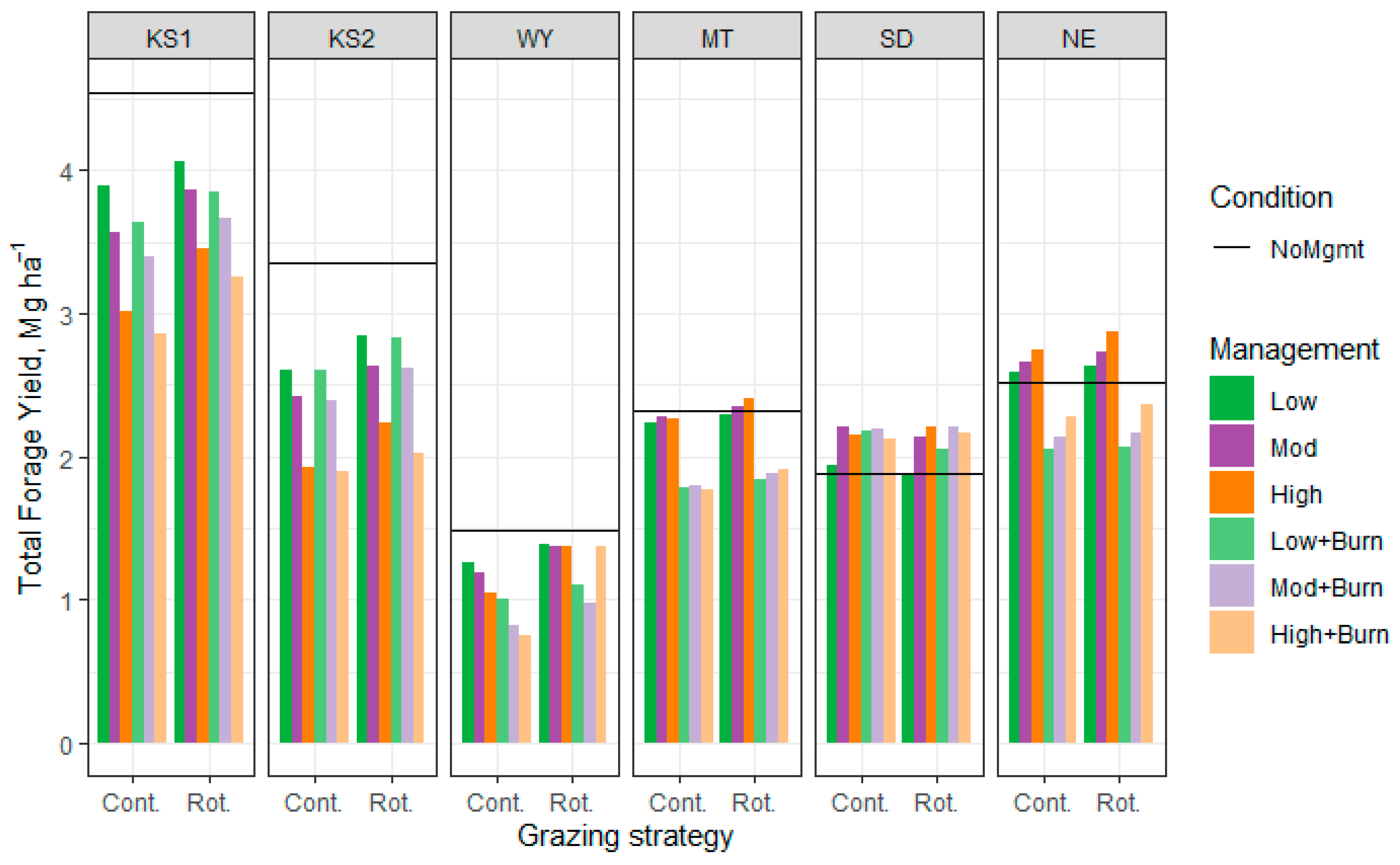

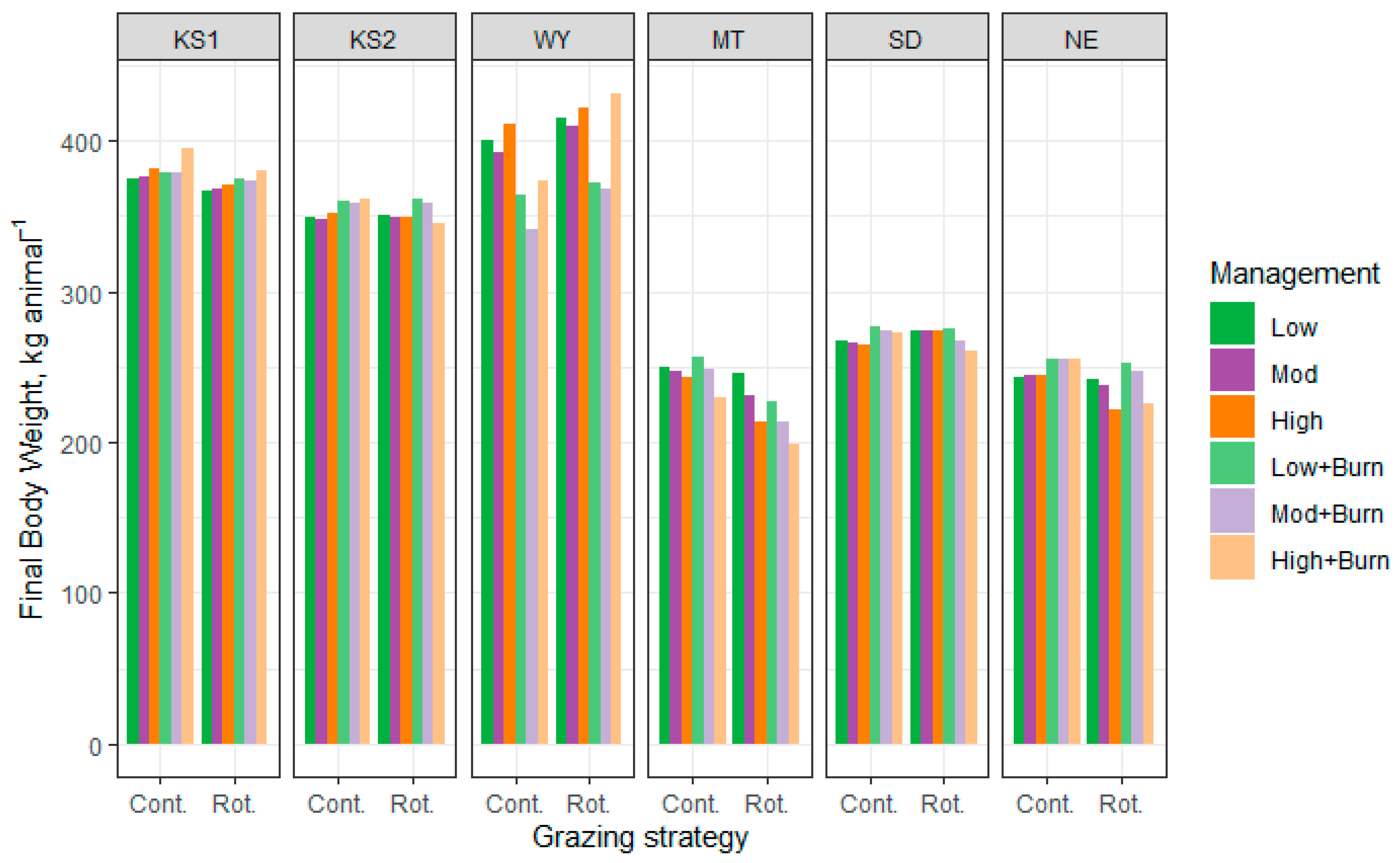
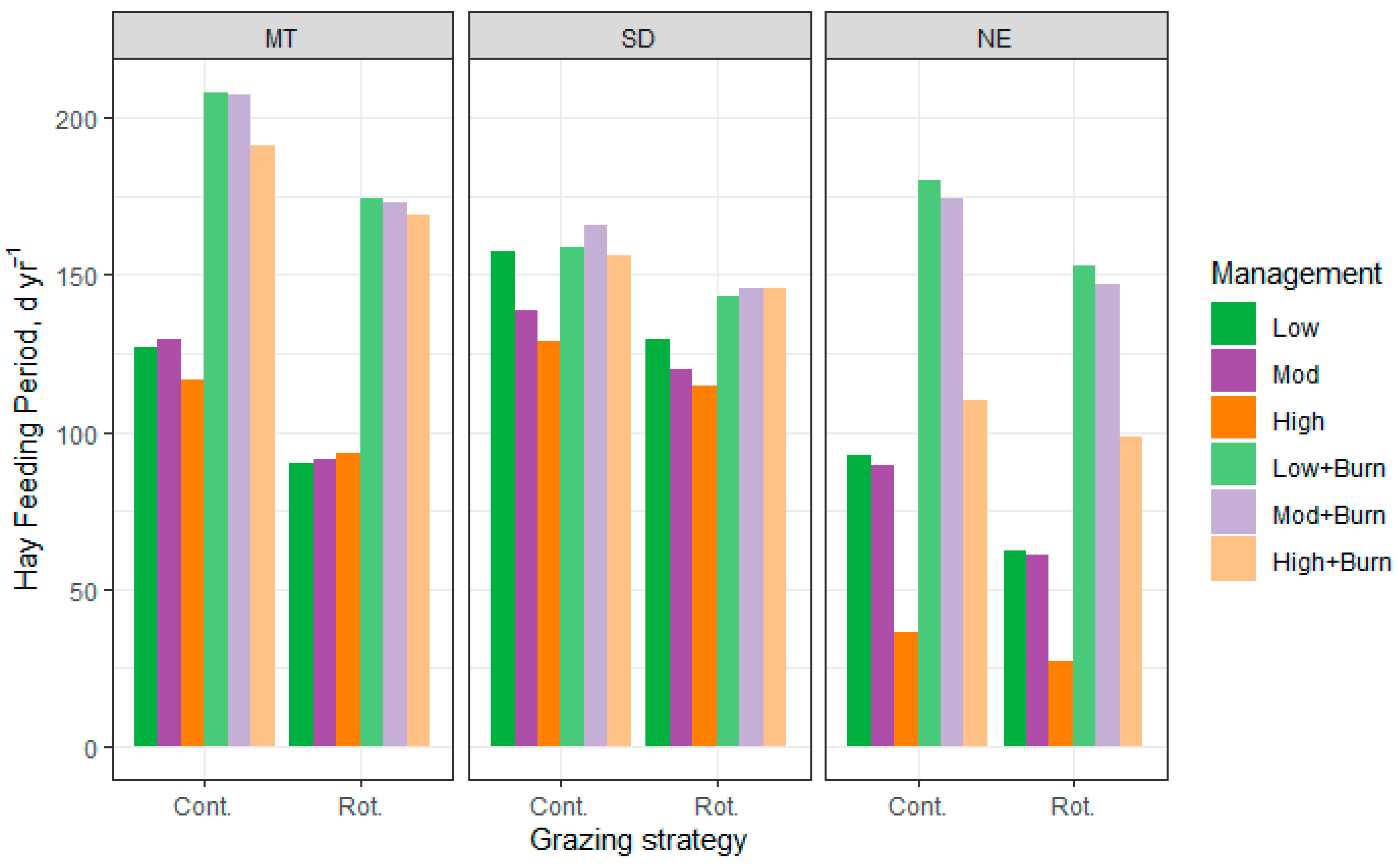
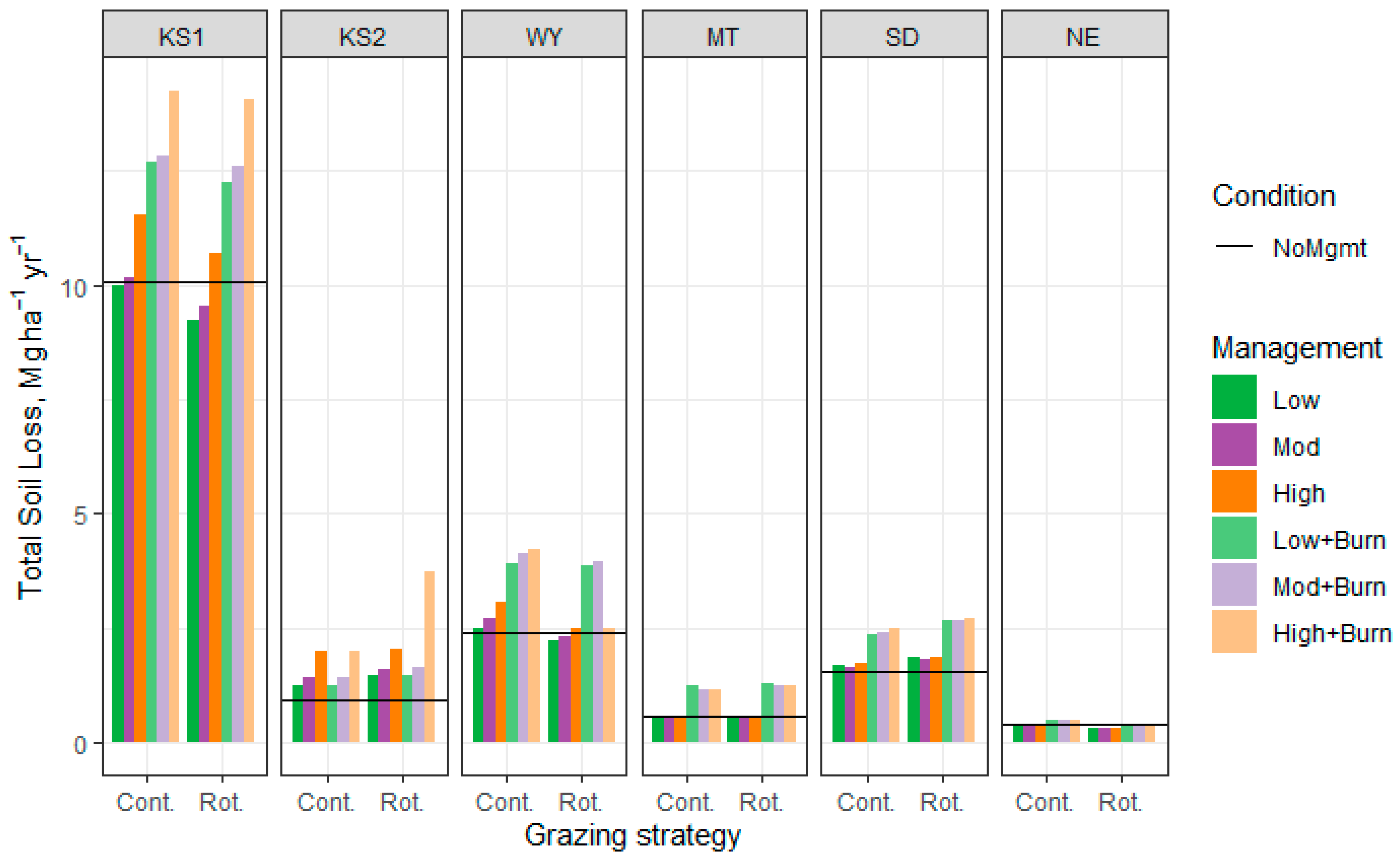

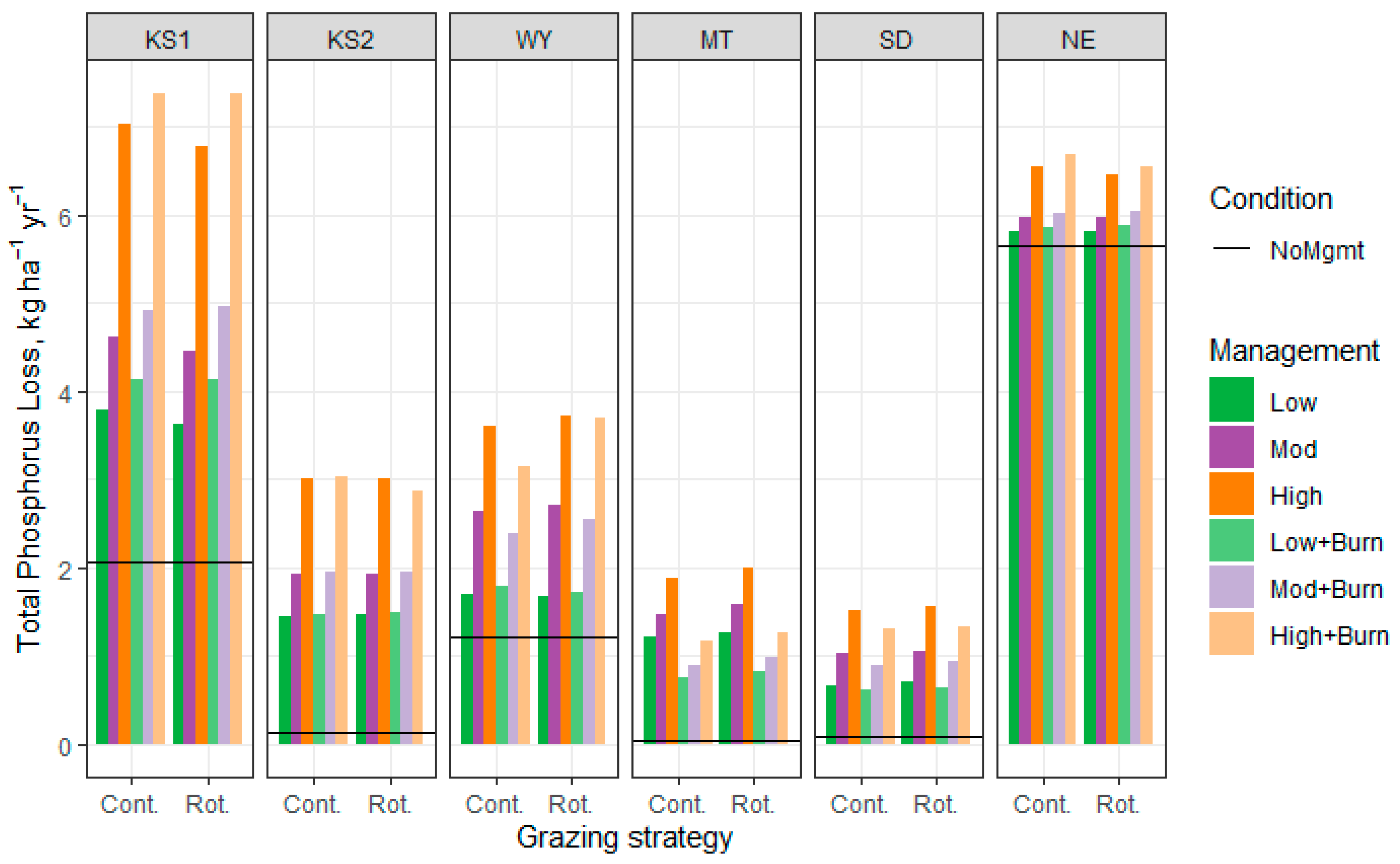
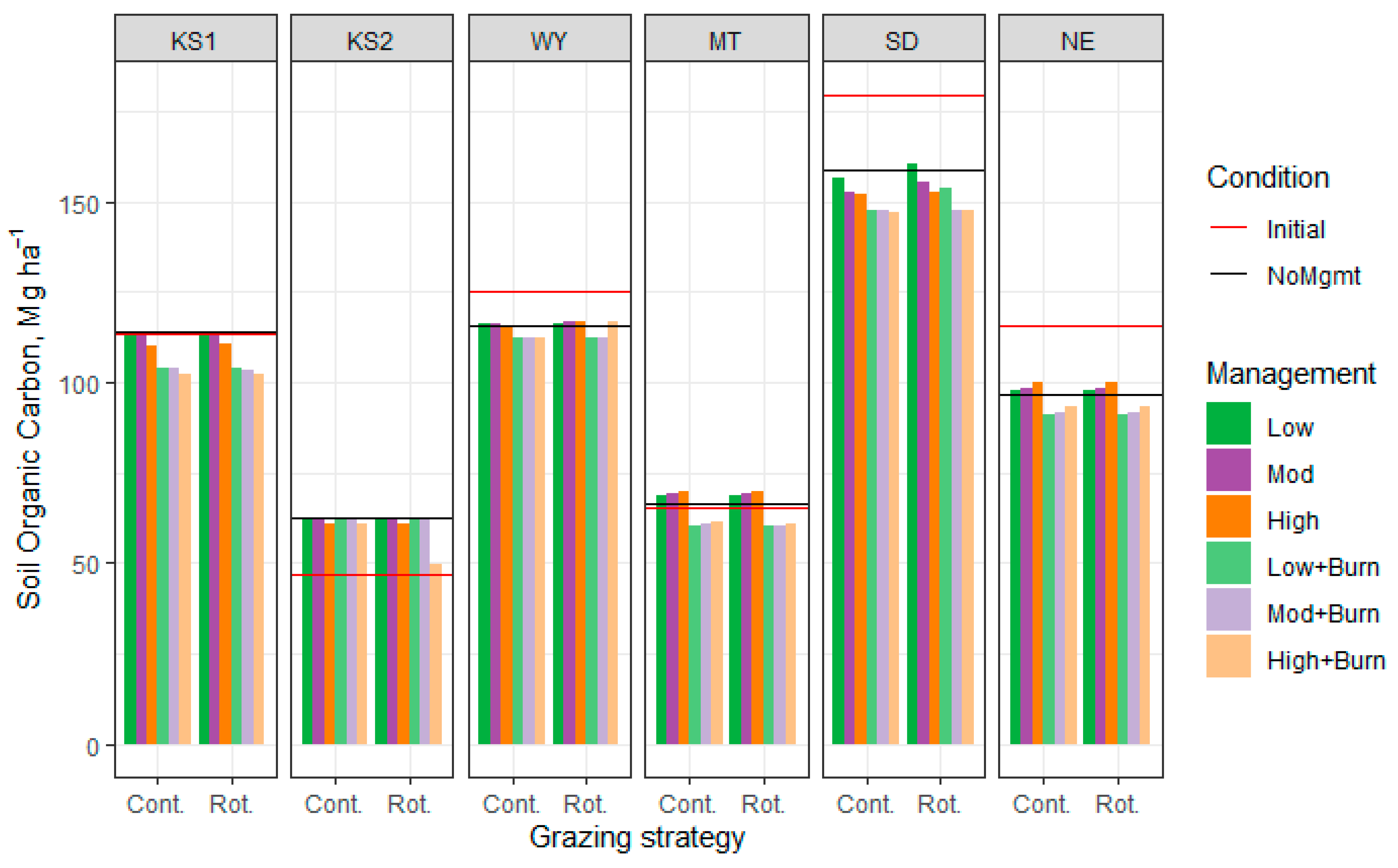
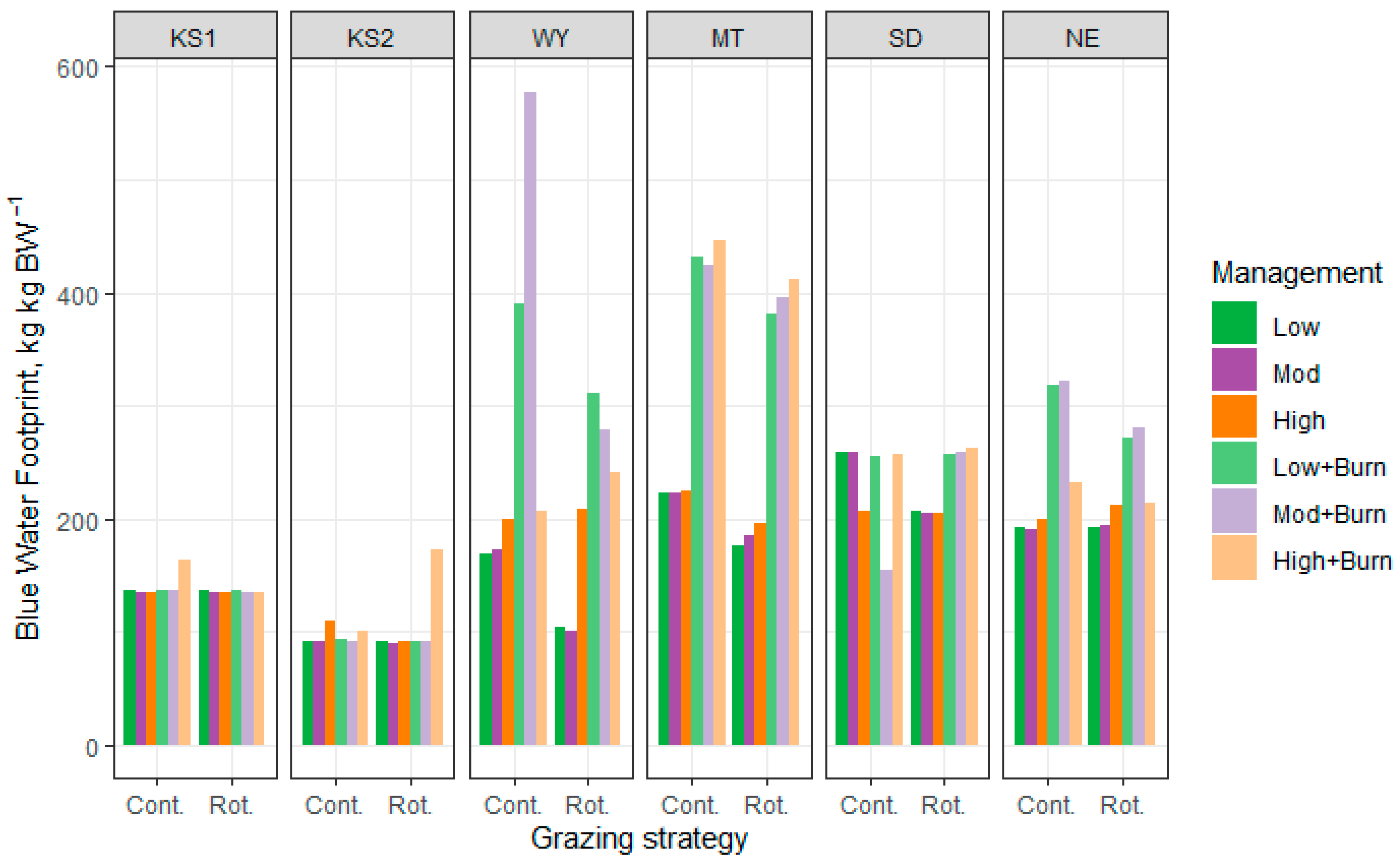
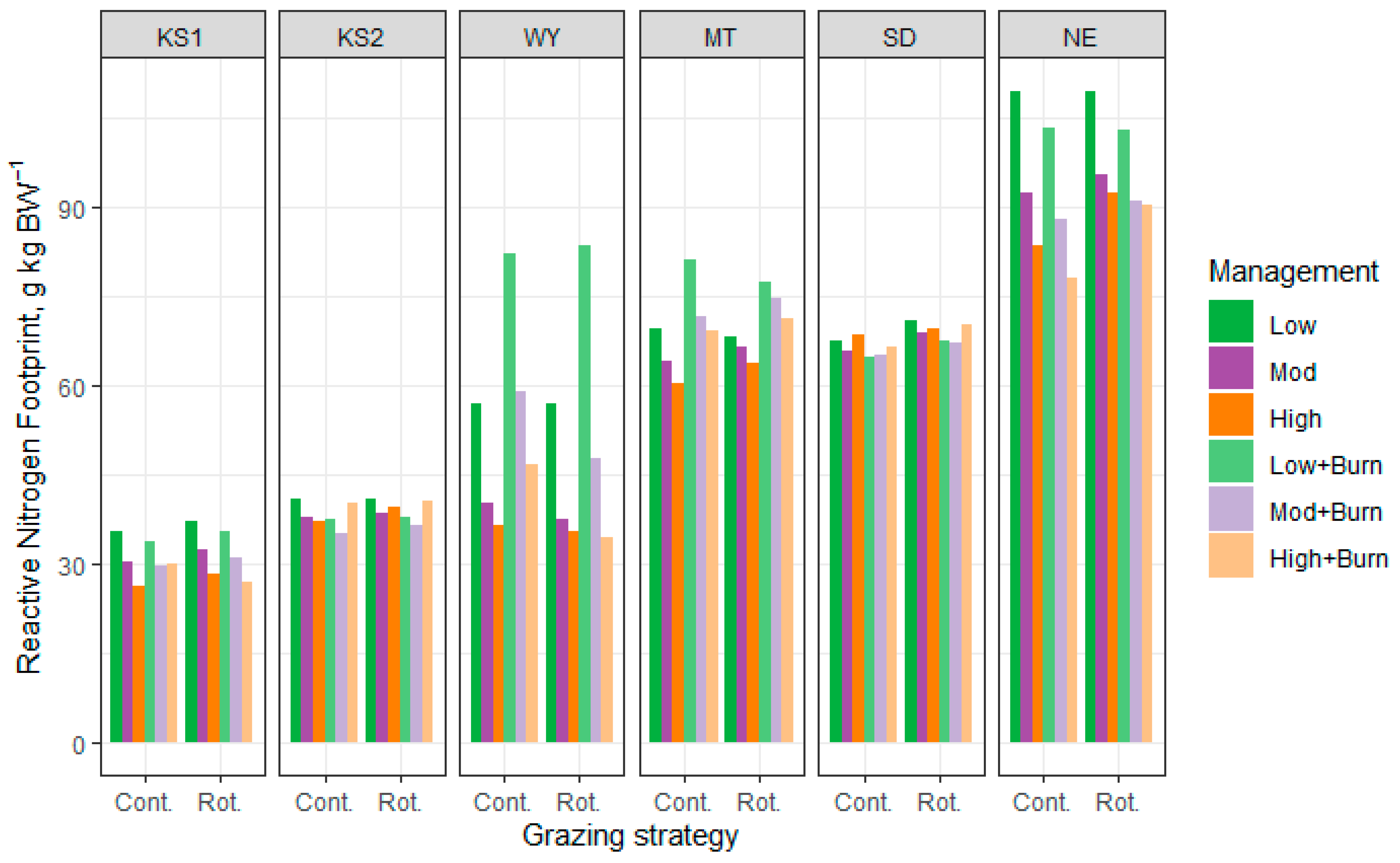
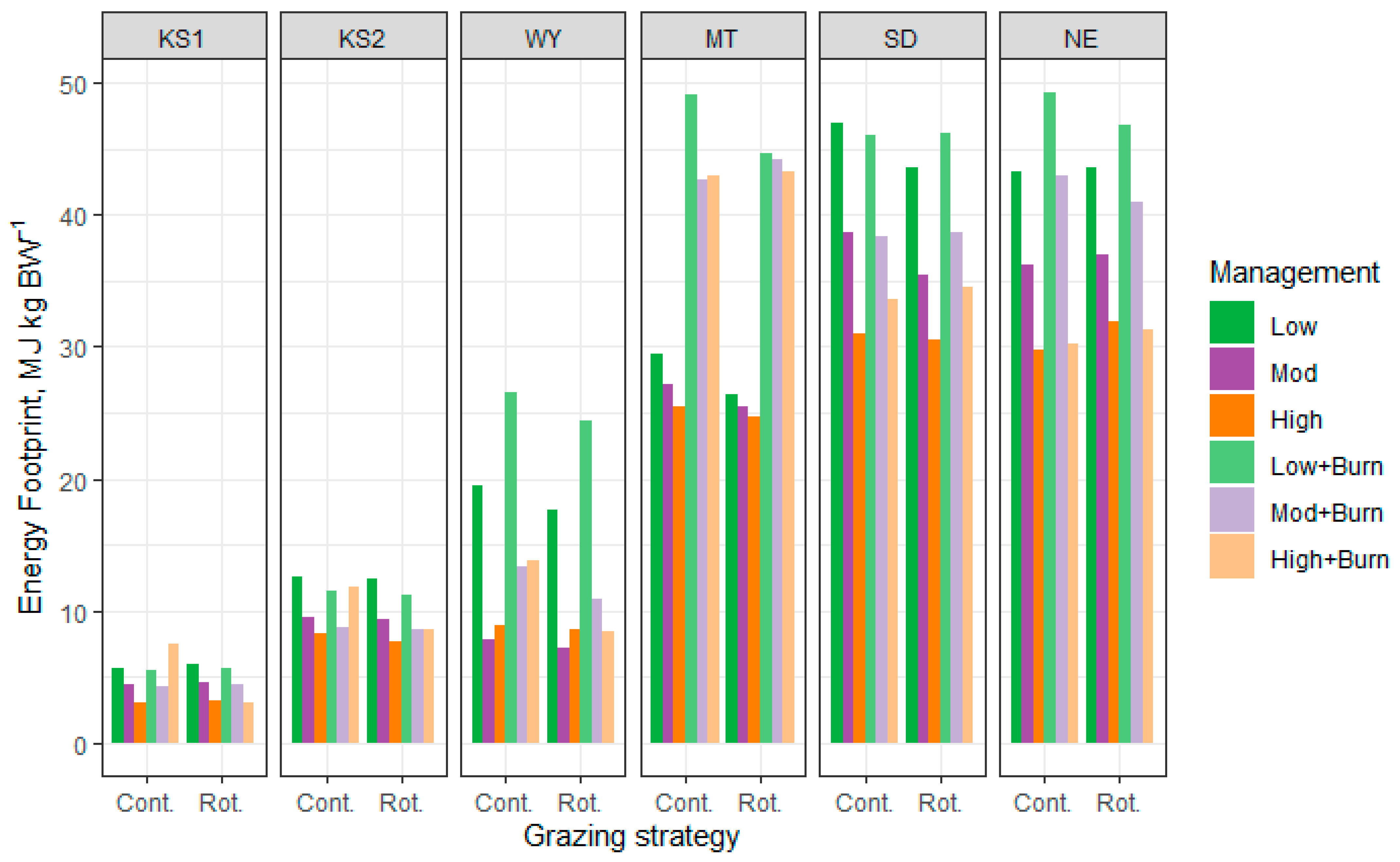
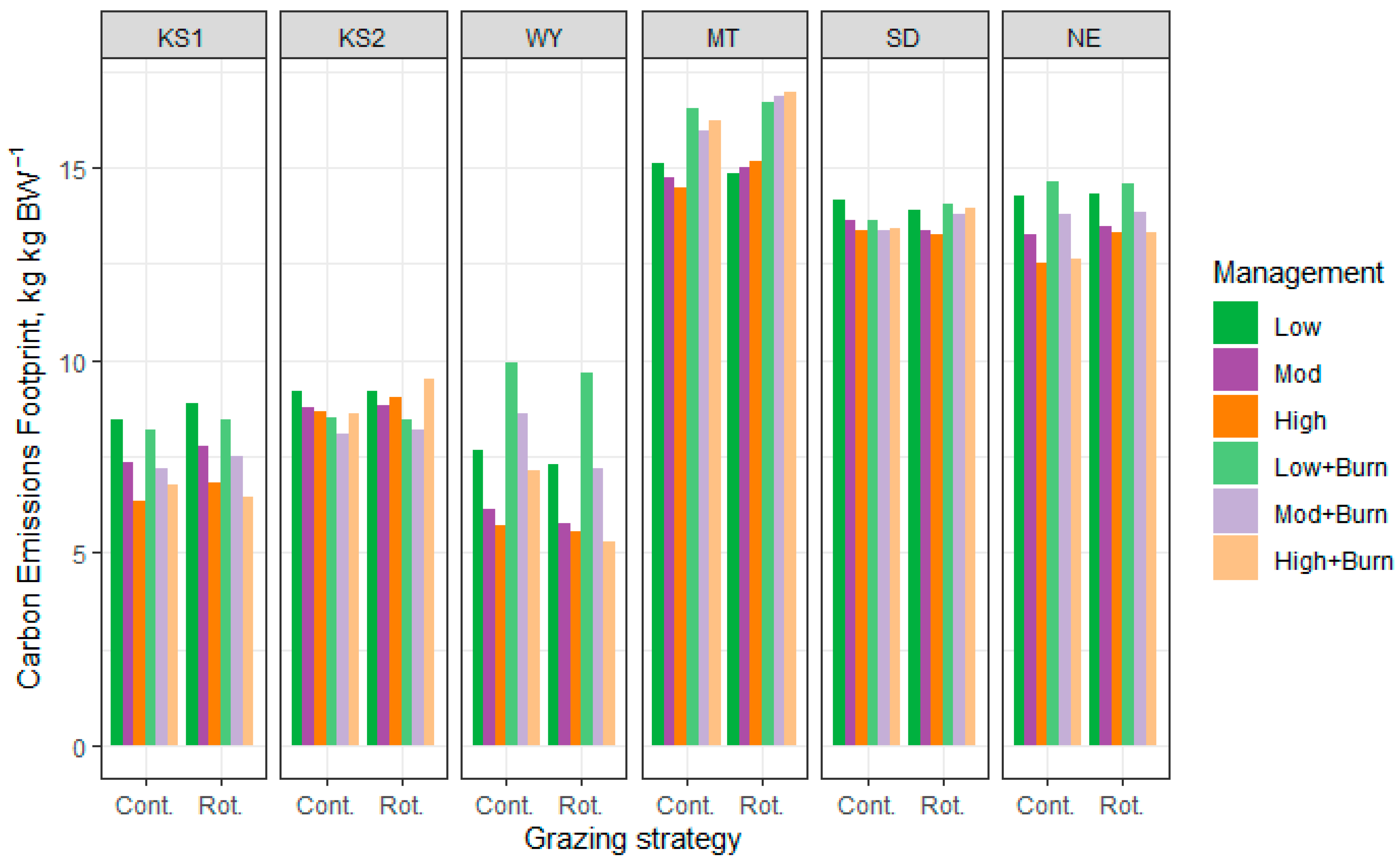
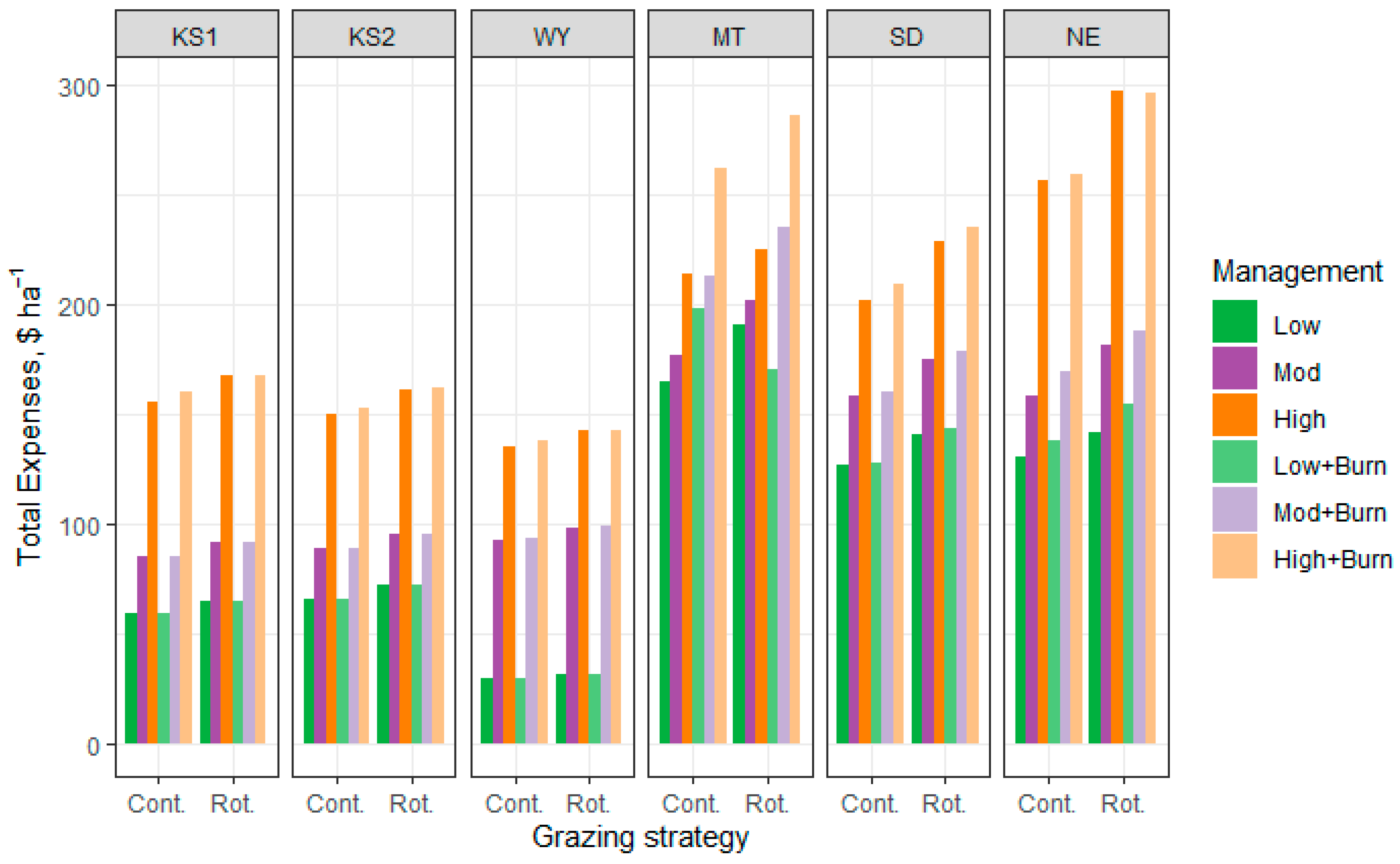

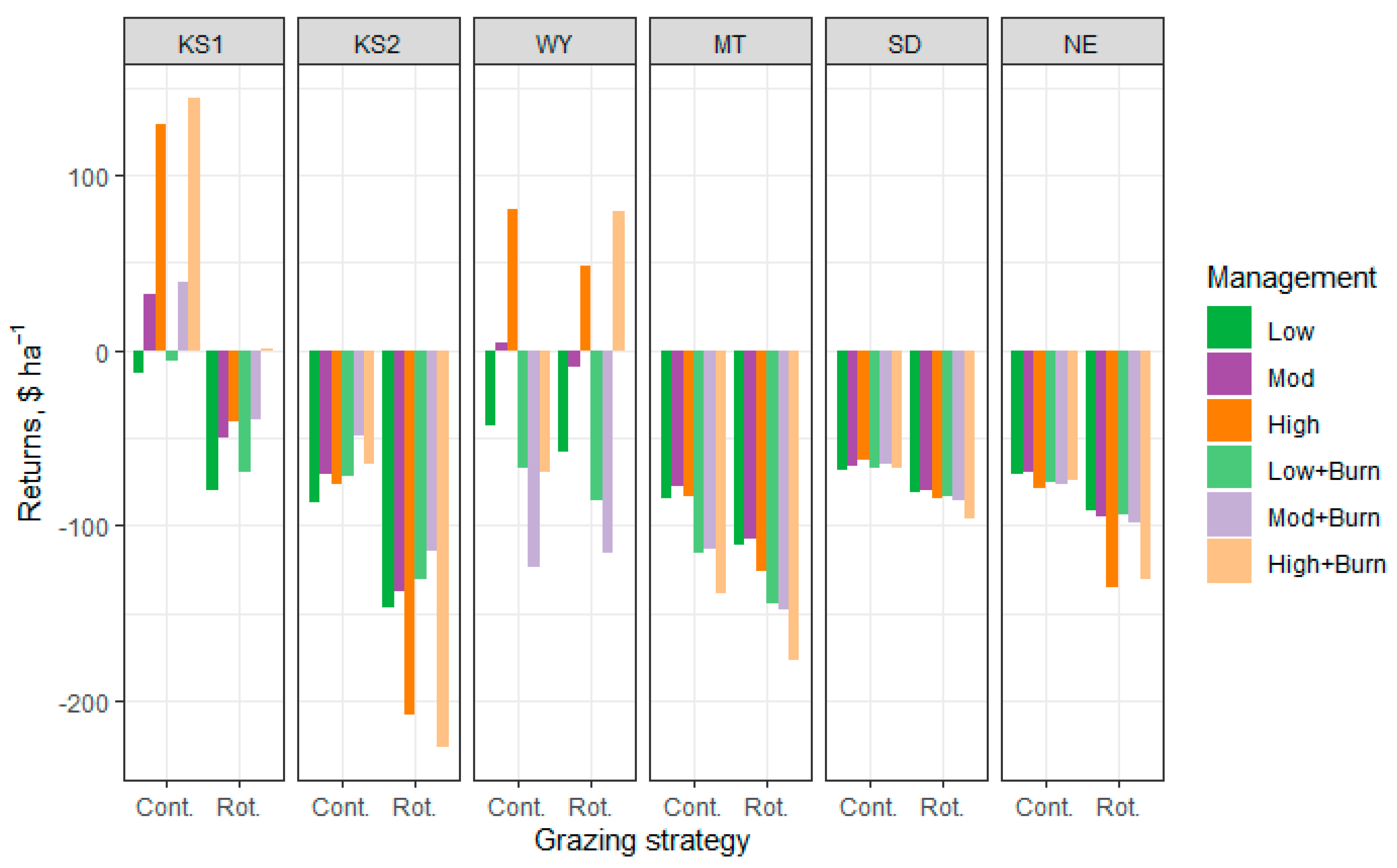
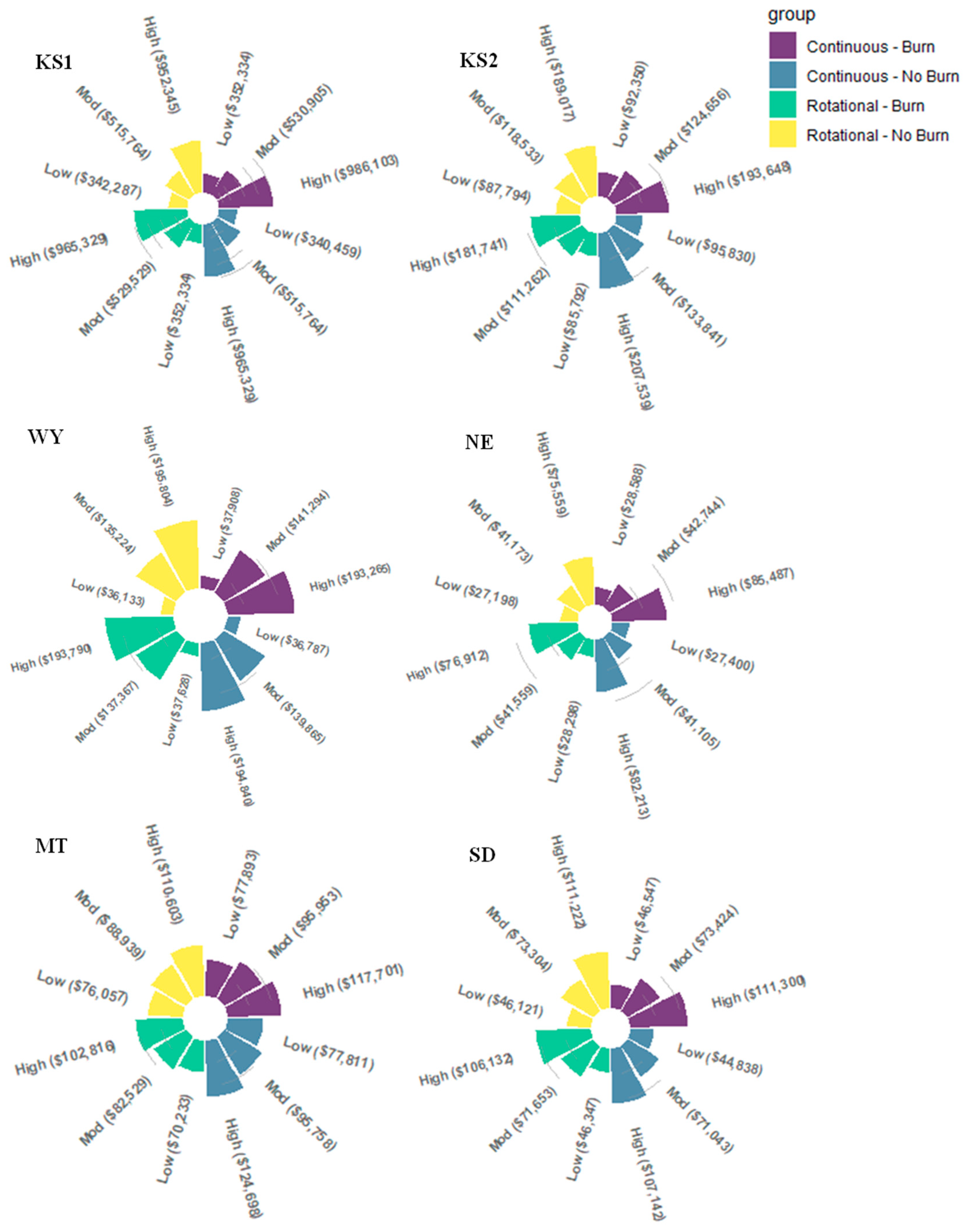
| Item | KS1 | KS2 | WY | MT | SD | NE |
|---|---|---|---|---|---|---|
| Latitude, longitude | 39.209, −96.592 | 38.859, −99.336 | 41.218, −104.876 | 46.408, −105.841 | 43.950, −101.895 | 42.027, −101.559 |
| Elevation, m | 332 | 613 | 1254 | 720 | 755 | 1048 |
| Area, ha | 1183 | 291 | 290 | 1746 | 1018 | 1098 |
| Soil series | CLIME-4590, slope 3–20% | BOGUE-ARMO-C, slope 5–25% | IPSON-430-GR-L, slope 6–30% | CAMBETH-44-SIL, Slope 15–25% | PIERRE-PSC-C, Slope 6–15% | VALENTINE-VAG-FS, Slope 9–60% |
| Weather | ||||||
| Avg Min Temp., C | 6.50 | 4.94 | 0.07 | 2.90 | 3.71 | 3.89 |
| Avg Max Temp., C | 19.25 | 19.85 | 14.39 | 15.42 | 16.88 | 16.60 |
| Avg Annual Precip., mm | 817 | 618 | 483 | 382 | 462 | 540 |
| Forage species simulated | Big bluestem Little bluestem Sideoats grama Buffalograss Japanese brome | Little bluestem Buffalograss Sideoats grama Western wheatgrass Big bluestem | Buffalograss Western wheatgrass Blue grama Forbs | Western wheatgrass Green needlegrass Other wheatgrasses Little bluestem Forbs | Western wheatgrass Sideoats grama Green needlegrass Blue grama | Blue grama Sand bluestem Prairie sandreed Little bluestem |
| Animal type | Stocker | Stocker | Stocker | Cow-calf | Cow-calf | Cow-calf |
| Stocking density, ha/animal | ||||||
| Low | 2.02 | 2.00 | 5.20 | 7.50 | 11.30 | 10.50 |
| Moderate | 1.34 | 1.40 | 1.37 | 6.00 | 7.10 | 7.00 |
| High | 0.71 | 0.80 | 0.93 | 4.50 | 4.70 | 3.50 |
| Grazing limit, t/ha | ||||||
| Continuous Low | 1.50 | 1.00 | 0.60 | 1.20 | 1.00 | 1.20 |
| Continuous Moderate | 1.50 | 1.00 | 0.60 | 1.20 | 1.00 | 1.20 |
| Continuous High | 0.93 | 0.68 | 0.41 | 1.16 | 0.61 | 0.79 |
| Rotational Low | 1.35 | 0.90 | 0.54 | 1.08 | 0.90 | 1.08 |
| Rotational Moderate | 1.35 | 0.90 | 0.54 | 1.08 | 0.90 | 1.08 |
| Rotational High | 0.93 | 0.68 | 0.41 | 1.06 | 0.61 | 0.79 |
| Grazing efficiency, % | ||||||
| Continuous Low | 43 | 44 | 27 | 46 | 42 | 43 |
| Continuous Moderate | 50 | 50 | 50 | 50 | 50 | 50 |
| Continuous High | 67 | 64 | 65 | 56 | 60 | 66 |
| Rotational Low | 58 | 59 | 42 | 61 | 57 | 58 |
| Rotational Moderate | 65 | 65 | 65 | 65 | 65 | 65 |
| Rotational High | 82 | 79 | 80 | 71 | 75 | 81 |
| Study Site | Base County, State | Counties Included |
|---|---|---|
| Konza Prairie Biological Station | Riley, Kansas | Clay, Geary, Marshall, Pottawatomie, Riley, Wabaunsee, Washington |
| Kansas State Research and Education Center | Ellis, Kansas | Barton, Ellis, Graham, Ness, Osborne, Rooks, Rush, Russel, Trego |
| High Plains Grassland Research Station | Laramie, Wyoming | Albany, Goshen, Laramie, Platte |
| Fort Keogh Livestock and Range Research Laboratory | Custer, Montana | Carter, Custer, Fallon, Garfield, Powder River, Prairie, Rosebud |
| Cottonwood Livestock and Range Field Station | Pennington, South Dakota | Custer, Haakon, Jackson, Lawrence, Meade, Pennington, Oglala-Lakota, Ziebach |
| Gudmundsen Sandhill Laboratory | Lincoln, Nebraska | Custer, Dawson, Frontier, Hayes, Keith, Lincoln, Logan, McPherson, Perkins |
| Field of Study | Research Focus | Experience |
|---|---|---|
| Animal Science | Grazing management; grazing cattle nutrition; stocker/cow–calf production systems | 15 years of academic experience; 48 peer-reviewed publications |
| Soil Science | Soil health; erosion control | 16 years of academic experience; 29 peer-reviewed publications; |
| Rangeland Ecology | Range management; weed science | 45 years of academic experience; 81 peer-reviewed publications |
| Agricultural Economics | Animal production and health economics | 17 years of academic experience; 54 peer-reviewed publications |
| Wildlife Biology | Grassland prairie ecosystems; mammals, birds, carnivores, and ungulates | 15 years of academic experience; 48 peer-reviewed publications |
| Indicator | Metric | Importance Score 1 | Sustainability Limit 2 | Description |
|---|---|---|---|---|
| Planet | ||||
| Soil Health | Soil erosion/sediment loss | 1.8 | 0.12–1.67 Mg/ha/yr | the amount of soil lost from water erosion |
| Change in soil carbon/organic matter | 1.8 | 1.01–5.54 Mg/ha/yr | the change in soil carbon (i.e., carbon sequestration) | |
| Climate | Carbon dioxide equivalent intensity | 1.4 | 7.70–14.35 kg CO2e/kg BW 3 | total greenhouse gas emissions (methane, nitrous oxide, carbon dioxide) converted to carbon dioxide basis using GWP100 |
| Blue water use | 1.4 | 92–1825 L/kg BW | the amount of surface and ground water (not precipitation) used | |
| Reactive nitrogen loss | 1.4 | 35.9–205.5 g N/kg BW | the amount of nitrogen-containing compounds (ammonia, nitrate, nitrous oxide) lost into the environment | |
| Biodiversity | Small mammal populations—multiple species | 0.5 | - | the number of small mammals (mice, moles, rats, shrews) trapped in a specified area |
| number small mammal species identified | 0.5 | - | the number of small mammal species trapped | |
| bird populations—multiple species | 0.5 | - | the number of birds (generally songbirds; no raptors or waterfowl) counted in a specified area | |
| number bird species identified | 0.75 | - | the number of different avian species identified | |
| number plant species identified | 1.75 | - | the number of different plant species identified | |
| Profit | ||||
| Economic | Rancher income | 2 | USD 15.93–46.22/hd | the net income of the operation |
| Induced/indirect economic impacts | 1 | 0.0 (indirect + induced)/direct | the broader economic impact in the community by the production of beef cattle (value added) | |
| People | ||||
| Food Security | Net nutrient conversion ratios | 1 | 1.0 | ratio of human-edible nutrients (protein, iron, phosphorus, B6, riboflavin, niacin, choline) produced to nutrients consumed |
| No Burn | Spring Burn | ||||||||||||
|---|---|---|---|---|---|---|---|---|---|---|---|---|---|
| Continuous | Rotational | Continuous | Rotational | ||||||||||
| Item 1 | No Mgmt | Low | Mod | High | Low | Mod | High | Low | Mod | High | Low | Mod | High |
| Protein | |||||||||||||
| KS1 | - | 3,956,185 | 4,039,169 | 3,809,463 | 3,611,386 | 3,687,794 | 3,996,728 | 4,147,883 | 4,212,640 | 193,152 | 3,946,536 | 3,912,228 | 3,769,097 |
| KS2 | - | 3,276,034 | 6,598,111 | 4,990,789 | 3,376,432 | 6,783,559 | 5,025,640 | 3,724,307 | 7,571,393 | 6,655,184 | 3,936,613 | 1,918,427 | 4,834,437 |
| WY | - | 838,687 | 2,880,440 | 199 | 948,303 | 3,384,704 | 116 | 562,099 | 6,240,448 | 2323 | 630,290 | 9,098,105 | 84 |
| MT | - | 1640 | 1374 | 1335 | 994 | 720 | 499 | 1151 | 1110 | 669 | 568 | 436 | 336 |
| SD | - | 106 | 110 | 100 | 75 | 76 | 75 | 87 | 96 | 101 | 87 | 103 | 114 |
| NE | - | 72 | 74 | 77 | 72 | 72 | 67 | 140 | 151 | 107 | 108 | 113 | 77 |
| Iron | |||||||||||||
| KS1 | - | 333.40 | 337.11 | 331.55 | 311.18 | 314.88 | 331.38 | 344.52 | 348.22 | 71.34 | 333.40 | 329.70 | 329.70 |
| KS2 | - | 259.62 | 370.10 | 334.19 | 265.15 | 375.62 | 320.38 | 287.24 | 408.77 | 367.34 | 298.29 | 207.15 | 309.34 |
| WY | - | 154.14 | 278.01 | 2.31 | 170.66 | 311.04 | 1.80 | 115.61 | 352.33 | 6.96 | 126.62 | 456.92 | 1.55 |
| MT | - | 3.77 | 3.43 | 3.37 | 2.94 | 2.47 | 2.02 | 3.53 | 3.12 | 2.39 | 2.27 | 1.96 | 1.68 |
| SD | - | 1.34 | 1.36 | 1.32 | 1.21 | 1.22 | 1.20 | 1.25 | 1.31 | 1.32 | 1.23 | 1.33 | 1.37 |
| NE | - | 1.25 | 1.26 | 1.26 | 1.24 | 1.25 | 1.18 | 1.53 | 1.58 | 1.37 | 1.38 | 1.39 | 1.21 |
| Selenium | |||||||||||||
| KS1 | - | 0.17 | 0.17 | 0.17 | 0.16 | 0.16 | 0.17 | 0.17 | 0.17 | 0.18 | 0.17 | 0.17 | 0.17 |
| KS2 | - | 0.13 | 0.19 | 0.17 | 0.13 | 0.19 | 0.16 | 0.14 | 0.21 | 0.18 | 0.15 | 0.10 | 0.16 |
| WY | - | 0.08 | 0.14 | 0.13 | 0.09 | 0.16 | 0.13 | 0.06 | 0.18 | 0.16 | 0.06 | 0.23 | 0.13 |
| MT | - | 0.08 | 0.08 | 0.07 | 0.08 | 0.07 | 0.06 | 0.11 | 0.09 | 0.08 | 0.08 | 0.08 | 0.07 |
| SD | - | 0.10 | 0.11 | 0.10 | 0.10 | 0.11 | 0.10 | 0.10 | 0.11 | 0.10 | 0.10 | 0.11 | 0.10 |
| NE | - | 0.11 | 0.11 | 0.11 | 0.11 | 0.11 | 0.11 | 0.11 | 0.11 | 0.10 | 0.11 | 0.11 | 0.11 |
| Zinc | |||||||||||||
| KS1 | - | 0.49 | 0.50 | 0.49 | 0.46 | 0.46 | 0.49 | 0.51 | 0.51 | 0.54 | 0.49 | 0.49 | 0.49 |
| KS2 | - | 0.38 | 0.54 | 0.49 | 0.39 | 0.55 | 0.47 | 0.42 | 0.60 | 0.54 | 0.44 | 0.30 | 0.46 |
| WY | - | 0.23 | 0.41 | 0.42 | 0.25 | 0.46 | 0.44 | 0.17 | 0.52 | 0.51 | 0.19 | 0.67 | 0.46 |
| MT | - | 0.26 | 0.24 | 0.23 | 0.25 | 0.23 | 0.21 | 0.34 | 0.28 | 0.24 | 0.25 | 0.25 | 0.25 |
| SD | - | 0.36 | 0.38 | 0.36 | 0.38 | 0.40 | 0.37 | 0.37 | 0.39 | 0.35 | 0.37 | 0.38 | 0.34 |
| NE | - | 0.43 | 0.42 | 0.42 | 0.43 | 0.42 | 0.40 | 0.41 | 0.41 | 0.36 | 0.41 | 0.40 | 0.39 |
| Phosphorus | |||||||||||||
| KS1 | - | 324 | 328 | 323 | 303 | 306 | 322 | 335 | 339 | 357 | 324 | 321 | 321 |
| KS2 | - | 253 | 360 | 325 | 258 | 365 | 312 | 279 | 398 | 357 | 290 | 202 | 301 |
| WY | - | 150 | 270 | 270 | 166 | 303 | 278 | 112 | 343 | 331 | 123 | 444 | 284 |
| MT | - | 165 | 153 | 146 | 161 | 144 | 132 | 214 | 177 | 155 | 157 | 159 | 155 |
| SD | - | 221 | 234 | 219 | 232 | 244 | 224 | 229 | 240 | 218 | 226 | 235 | 213 |
| NE | - | 260 | 258 | 255 | 258 | 255 | 241 | 253 | 252 | 220 | 252 | 247 | 239 |
| No Burn | Spring Burn | ||||||||||||
|---|---|---|---|---|---|---|---|---|---|---|---|---|---|
| Continuous | Rotational | Continuous | Rotational | ||||||||||
| Item 1 | No Mgmt | Low | Mod | High | Low | Mod | High | Low | Mod | High | Low | Mod | High |
| Pyridoxine (B6) | |||||||||||||
| KS1 | - | 172.33 | 174.24 | 171.37 | 160.84 | 162.75 | 171.28 | 178.07 | 179.98 | 36.87 | 172.33 | 170.41 | 170.41 |
| KS2 | - | 134.19 | 191.29 | 172.73 | 137.05 | 194.15 | 165.60 | 148.47 | 211.28 | 189.86 | 154.18 | 107.07 | 159.89 |
| WY | - | 79.67 | 143.69 | 1.19 | 88.21 | 160.76 | 0.93 | 59.75 | 182.11 | 3.60 | 65.44 | 236.17 | 0.80 |
| MT | - | 1.93 | 1.76 | 1.73 | 1.51 | 1.27 | 1.04 | 1.81 | 1.60 | 1.23 | 1.16 | 1.00 | 0.86 |
| SD | - | 0.69 | 0.70 | 0.68 | 0.62 | 0.63 | 0.62 | 0.64 | 0.67 | 0.68 | 0.63 | 0.68 | 0.71 |
| NE | - | 0.64 | 0.65 | 0.65 | 0.64 | 0.64 | 0.60 | 0.79 | 0.81 | 0.70 | 0.71 | 0.72 | 0.62 |
| Riboflavin (B2) | |||||||||||||
| KS1 | - | 789.94 | 798.71 | 785.55 | 737.27 | 746.05 | 785.15 | 816.27 | 825.05 | 169.03 | 789.94 | 781.16 | 781.16 |
| KS2 | - | 615.12 | 876.88 | 791.81 | 628.21 | 889.96 | 759.09 | 680.56 | 968.49 | 870.33 | 706.74 | 490.79 | 732.91 |
| WY | - | 365.21 | 658.68 | 5.47 | 404.34 | 736.94 | 4.27 | 273.91 | 834.76 | 16.50 | 299.99 | 1082.59 | 3.67 |
| MT | - | 8.09 | 7.36 | 7.22 | 6.32 | 5.29 | 4.30 | 7.60 | 6.69 | 5.10 | 4.84 | 4.16 | 3.56 |
| SD | - | 2.87 | 2.93 | 2.85 | 2.61 | 2.63 | 2.59 | 2.70 | 2.82 | 2.84 | 2.66 | 2.85 | 2.96 |
| NE | - | 2.68 | 2.70 | 2.71 | 2.66 | 2.67 | 2.51 | 3.28 | 3.39 | 2.94 | 2.96 | 2.99 | 2.59 |
| Niacin | |||||||||||||
| KS1 | - | 844.78 | 854.17 | 840.09 | 788.46 | 797.85 | 839.66 | 872.94 | 882.33 | 180.77 | 844.78 | 835.40 | 835.40 |
| KS2 | - | 657.83 | 937.76 | 846.78 | 671.83 | 951.75 | 811.79 | 727.81 | 1035.73 | 930.76 | 755.81 | 524.86 | 783.80 |
| WY | - | 390.57 | 704.41 | 5.85 | 432.41 | 788.11 | 4.57 | 292.92 | 892.72 | 17.64 | 320.82 | 1157.75 | 3.93 |
| MT | - | 9.36 | 8.52 | 8.37 | 7.31 | 6.14 | 5.01 | 8.78 | 7.74 | 5.93 | 5.62 | 4.85 | 4.16 |
| SD | - | 3.32 | 3.38 | 3.29 | 3.01 | 3.04 | 2.98 | 3.11 | 3.26 | 3.28 | 3.07 | 3.29 | 3.41 |
| NE | - | 3.10 | 3.12 | 3.14 | 3.09 | 3.09 | 2.92 | 3.80 | 3.92 | 3.40 | 3.43 | 3.46 | 3.01 |
| Choline | |||||||||||||
| KS1 | - | 339.52 | 343.30 | 337.64 | 316.89 | 320.66 | 337.47 | 350.84 | 354.61 | 72.65 | 339.52 | 335.75 | 335.75 |
| KS2 | - | 264.39 | 376.89 | 340.33 | 270.01 | 382.52 | 326.26 | 292.51 | 416.27 | 374.08 | 303.76 | 210.95 | 315.01 |
| WY | - | 156.97 | 283.11 | 2.35 | 173.79 | 316.75 | 1.83 | 117.73 | 358.79 | 7.09 | 128.94 | 465.31 | 1.58 |
| MT | - | 3.74 | 3.41 | 3.35 | 2.92 | 2.45 | 2.00 | 3.51 | 3.09 | 2.37 | 2.25 | 1.94 | 1.66 |
| SD | - | 1.33 | 1.35 | 1.32 | 1.20 | 1.21 | 1.19 | 1.24 | 1.30 | 1.31 | 1.23 | 1.32 | 1.36 |
| NE | - | 1.24 | 1.25 | 1.25 | 1.23 | 1.24 | 1.17 | 1.52 | 1.57 | 1.36 | 1.37 | 1.38 | 1.21 |
| No Burn | Spring Burn | ||||||||||||
|---|---|---|---|---|---|---|---|---|---|---|---|---|---|
| Continuous | Rotational | Continuous | Rotational | ||||||||||
| Item 1 | No Mgmt | Low | Mod | High | Low | Mod | High | Low | Mod | High | Low | Mod | High |
| People 2 | |||||||||||||
| KS1 | - | 1.49 | 1.50 | 1.49 | 1.47 | 1.48 | 1.49 | 1.50 | 1.50 | 1.20 | 1.19 | 1.49 | 1.49 |
| KS2 | - | 1.15 | 1.23 | 1.21 | 1.15 | 1.23 | 1.20 | 1.17 | 1.25 | 1.23 | 1.18 | 1.09 | 1.19 |
| WY | - | 1.02 | 1.16 | 0.37 | 1.04 | 1.18 | 0.32 | 0.95 | 1.22 | 0.61 | 0.97 | 1.27 | 0.29 |
| MT | - | 0.37 | 0.35 | 0.34 | 0.33 | 0.28 | 0.24 | 0.39 | 0.35 | 0.29 | 0.28 | 0.25 | 0.22 |
| SD | - | 0.15 | 0.16 | 0.15 | 0.13 | 0.14 | 0.13 | 0.14 | 0.16 | 0.15 | 0.14 | 0.16 | 0.15 |
| NE | - | 0.07 | 0.07 | 0.07 | 0.07 | 0.06 | 0.05 | 0.10 | 0.10 | 0.07 | 0.08 | 0.08 | 0.06 |
| Planet | |||||||||||||
| KS1 | - | 1.17 | 1.24 | 0.89 | 1.46 | 1.52 | 1.19 | 0.52 | 0.59 | 0.18 | 0.79 | 0.84 | 0.51 |
| KS2 | - | 2.09 | 2.12 | 1.80 | 2.34 | 2.36 | 2.02 | 1.88 | 1.90 | 1.50 | 2.14 | 2.14 | 1.35 |
| WY | - | 1.39 | 1.60 | 1.33 | 1.70 | 1.96 | 1.69 | 0.57 | 0.81 | 0.75 | 0.86 | 1.29 | 1.44 |
| MT | - | 1.12 | 1.20 | 0.99 | 1.46 | 1.47 | 1.22 | 0.21 | 0.32 | 0.07 | 0.55 | 0.56 | 0.31 |
| SD | - | 0.49 | 0.44 | 0.20 | 0.86 | 0.80 | 0.47 | 0.03 | 0.15 | −0.26 | 0.35 | 0.24 | −0.07 |
| NE | - | 0.39 | 0.60 | 0.47 | 0.66 | 0.84 | 0.62 | −0.13 | 0.06 | 0.06 | 0.19 | 0.34 | 0.19 |
| Profit | |||||||||||||
| KS1 | - | 1.18 | 1.38 | 1.57 | 0.92 | 1.17 | 1.33 | 1.21 | 1.40 | 1.59 | 0.96 | 1.20 | 1.39 |
| KS2 | - | 0.64 | 0.86 | 1.03 | 0.39 | 0.66 | 0.81 | 0.73 | 0.91 | 1.03 | 0.43 | 0.70 | 0.77 |
| WY | - | −0.07 | 1.08 | 1.81 | −0.33 | 0.90 | 1.53 | −0.45 | −0.54 | 0.50 | −0.77 | −0.45 | 1.79 |
| MT | - | −0.43 | −0.05 | 0.18 | −0.83 | −0.43 | −0.22 | −0.88 | −0.47 | −0.30 | −1.33 | −0.91 | −0.67 |
| SD | - | −0.76 | −0.03 | 0.42 | −1.01 | −0.21 | 0.23 | −0.72 | 0.00 | 0.39 | −1.06 | −0.30 | 0.11 |
| NE | - | −0.98 | −0.34 | 0.28 | −1.40 | −0.69 | −0.12 | −1.05 | −0.43 | 0.33 | −1.43 | −0.72 | −0.09 |
| Overall | |||||||||||||
| KS1 | - | 1.27 | 1.36 | 1.30 | 1.27 | 1.37 | 1.32 | 1.07 | 1.15 | 0.98 | 0.97 | 1.16 | 1.12 |
| KS2 | - | 1.28 | 1.39 | 1.33 | 1.28 | 1.40 | 1.33 | 1.25 | 1.34 | 1.24 | 1.24 | 1.30 | 1.09 |
| WY | - | 0.77 | 1.27 | 1.16 | 0.80 | 1.33 | 1.17 | 0.35 | 0.49 | 0.62 | 0.35 | 0.70 | 1.16 |
| MT | - | 0.35 | 0.50 | 0.50 | 0.31 | 0.44 | 0.41 | −0.09 | 0.07 | 0.02 | −0.16 | −0.03 | −0.05 |
| SD | - | −0.04 | 0.19 | 0.25 | −0.01 | 0.24 | 0.27 | −0.18 | 0.10 | 0.09 | −0.19 | 0.03 | 0.06 |
| NE | - | −0.17 | 0.11 | 0.27 | −0.22 | 0.07 | 0.18 | −0.36 | −0.09 | 0.15 | −0.38 | −0.10 | 0.05 |
Disclaimer/Publisher’s Note: The statements, opinions and data contained in all publications are solely those of the individual author(s) and contributor(s) and not of MDPI and/or the editor(s). MDPI and/or the editor(s) disclaim responsibility for any injury to people or property resulting from any ideas, methods, instructions or products referred to in the content. |
© 2023 by the authors. Licensee MDPI, Basel, Switzerland. This article is an open access article distributed under the terms and conditions of the Creative Commons Attribution (CC BY) license (https://creativecommons.org/licenses/by/4.0/).
Share and Cite
Day, M.E.; Tang, M.; Lancaster, P.A.; Presley, D.; Pendell, D.L.; Fick, W.H.; Doro, L.; Ahlers, A.; Ricketts, A. Simulation of the Impact of Rangeland Management Strategies on Soil Health, Environmental Footprint, Economic Impact, and Human-Edible Nutrient Conversion from Grasslands in the Central and Northern Great Plains of the United States. Sustainability 2023, 15, 12456. https://doi.org/10.3390/su151612456
Day ME, Tang M, Lancaster PA, Presley D, Pendell DL, Fick WH, Doro L, Ahlers A, Ricketts A. Simulation of the Impact of Rangeland Management Strategies on Soil Health, Environmental Footprint, Economic Impact, and Human-Edible Nutrient Conversion from Grasslands in the Central and Northern Great Plains of the United States. Sustainability. 2023; 15(16):12456. https://doi.org/10.3390/su151612456
Chicago/Turabian StyleDay, Merri E., Minfeng Tang, Phillip A. Lancaster, Deann Presley, Dustin L. Pendell, Walter H. Fick, Luca Doro, Adam Ahlers, and Andrew Ricketts. 2023. "Simulation of the Impact of Rangeland Management Strategies on Soil Health, Environmental Footprint, Economic Impact, and Human-Edible Nutrient Conversion from Grasslands in the Central and Northern Great Plains of the United States" Sustainability 15, no. 16: 12456. https://doi.org/10.3390/su151612456
APA StyleDay, M. E., Tang, M., Lancaster, P. A., Presley, D., Pendell, D. L., Fick, W. H., Doro, L., Ahlers, A., & Ricketts, A. (2023). Simulation of the Impact of Rangeland Management Strategies on Soil Health, Environmental Footprint, Economic Impact, and Human-Edible Nutrient Conversion from Grasslands in the Central and Northern Great Plains of the United States. Sustainability, 15(16), 12456. https://doi.org/10.3390/su151612456






